Notice
is given that an ordinary meeting of the Strategy and Policy Committee will be
held on:
MEMBERSHIP
|
Chairperson
|
Cr K Maling
|
|
|
Deputy
Chairperson
|
Cr C Butler
|
|
|
Members
|
Mayor T King
|
Cr C Hill
|
|
|
Deputy Mayor S
Bryant
|
Cr M
Kininmonth
|
|
|
Cr G Daikee
|
Cr C Mackenzie
|
|
|
Cr B Dowler
|
Cr B Maru
|
|
|
Cr J Ellis
|
Cr D
Shallcrass
|
|
|
Cr M Greening
|
Cr T Walker
|
(Quorum 7 members)
|
|
|
Contact Telephone: 03 543 8400
Email: tdc.governance@tasman.govt.nz
Website:
www.tasman.govt.nz
|
Strategy and
Policy Committee Agenda – 19 February 2025
AGENDA
1 Opening, Welcome, KARAKIA
2 Apologies
and Leave of Absence
|
Recommendation
That apologies be accepted.
|
3 Public
Forum
3.1 Waimea
Inlet Coordinating Group........................................................................... 4
4 Declarations
of Interest
5 LATE
ITEMS
6 Confirmation
of minutes
|
That the minutes of
the Strategy and Policy Committee meeting held on Thursday, 14 November 2024,
be confirmed as a true and correct record of the meeting.
|
7 Reports
7.1 Chair's
Report.......................................................................................................... 5
7.2 Independent
Peer Review Report on Te Waikoropupū Springs Water Conservation Order
Catchment................................................................................................................ 7
7.3 Heritage
Advisory Group Terms of Reference...................................................... 78
7.4 Waimea
Inlet Action Plan Annual Progress Report.............................................. 83
7.5 Strategic
Policy and Environmental Policy Activity Report................................. 109
8 Confidential
Session
8.1 Procedural
motion to exclude the public............................................................. 129
8.2 Hearing
Panel's recommendation to Council for TRMP Plan Change 80 - Motueka West............................................................................................................................. 129
9 CLOSING
KARAKIA
Strategy and
Policy Committee Agenda – 19 February 2025
3 Public
Forum
3.1
Waimea Inlet
Coordinating Group
|
Report
To:
|
Strategy
and Policy Committee
|
|
Meeting
Date:
|
19
February 2025
|
|
Report
Author:
|
Gavin
Dawson, Governance Advisor
|
|
Report
Authorisers:
|
John
Ridd, Group Manager - Service and Strategy
|
|
Report
Number:
|
RSPC25-02-1
|
1. Public
Forum / Te Matapaki Tūmatanui
Sky Davies, representing the Waimea Inlet
Coordinating Group, will speak in public forum
regarding the Waimea Inlet Strategy and Action Plan update report.
Nil
Strategy and
Policy Committee Agenda – 19 February 2025
7 Reports
7.1
Chair's Report
Information Only - No Decision
Required
|
Report
To:
|
Strategy
and Policy Committee
|
|
Meeting
Date:
|
19
February 2025
|
|
Report
Author:
|
Kit
Maling, Chairperson Strategy and Policy Committee
|
|
Report
Authorisers:
|
John
Ridd, Group Manager - Service and Strategy
|
|
Report
Number:
|
RSPC25-02-2
|
1. Summary
/ Te Tuhinga Whakarāpoto
1.1 This is the
Chair’s monthly report to the Strategy and Policy Committee.
2. Recommendation/s
/ Ngā Tūtohunga
That the Strategy and
Policy Committee
1. receives the Chair's Report, RSPC25-02-2.
3.1 Welcome everyone
to today’s Strategy and Policy Committee meeting. This is our first
meeting of the year and I would like to welcome everyone back. I hope you had a
chance to enjoy our beautiful region over the summer break as I did in Golden
Bay. On the weekend I was in Kaiteriteri at a wedding function, so I have
included a photo of our beautiful region. Now it’s back to work!

3.2 This last year
of our triennium is going to be reasonably busy. We have a number of plan
changes to complete and work on the Tasman Resource Management Plan. I will
briefly detail some of the work:
- Wakefield Growth
Plan Change is appealed. Mediation is set for the second quarter of this year;
- Urban Growth Plan
Change 81 – draft to be released in the first quarter of this year;
- Deferred Zoning
Plan Change 79 – the hearing is due to be in the second quarter of this
year;
- Outstanding
Natural Features Landscapes (ONFL) is due for public notification in the third
quarter of this year;
- Mapua Masterplan
(which is under the Local Government Act) - a hearing is set for next month;
- Port Tarakohe
Structure Plan is also due this first quarter; and
- Port Motueka
Structure Plan.
3.3 As you can see,
things are not slowing down even though we are coming into the third year of
our triennium. It will be good to progress these matters. It is my
understanding that a number of national policy statements are being delayed and
will not be issued in the timely manner that was expected. We hope to have more
information on this in the near future.
Nil
Strategy and
Policy Committee Agenda – 19 February 2025
7.2 Independent Peer Review Report on Te Waikoropupū
Springs Water Conservation Order Catchment
Decision Required
|
Report
To:
|
Strategy
and Policy Committee
|
|
Meeting
Date:
|
19
February 2025
|
|
Report
Author:
|
Joseph
Thomas, Principal Scientist - Water & Special Projects
|
|
Report
Authorisers:
|
Rob
Smith, Group Manager - Environmental Science
|
|
Report
Number:
|
RSPC25-02-3
|
1. Purpose
of the Report / Te Take mō te Pūrongo
1.1 For
Council to receive and endorse the recommendations of the independent peer
review report, which is attached to the report as Attachment 1, of
monitoring associated with the Te Waikoropupū Springs (TWS) and its recharge area
(catchment).
2. Summary
/ Te Tuhinga Whakarāpoto
2.1 The
independent peer reviewer, Murray Close of the
Institute of Environmental Science and Research (ESR) a Crown Research
Institute, visited the area twice in July and October 2024 and has engaged with
key stake holders and partners in the catchment related to the Water
Conservation Order (WCO), including Ngāti Tama and
the Golden Bay Community Board.
2.2 The
peer reviewer has reviewed key documents and data related to the water
conservation order and has also engaged with a range of technical experts that
were involved in the hearings for the WCO.
2.3 The
peer reviewer’s key recommendation in relation to monitoring are for
monthly monitoring for a range of water quality parameters at seven groundwater
sites, three springs sites (all within the Te Waikoropupū Springs) and six
surface water sites. An initial extensive list of parameters is recommended to
be tested to establish overall background levels and then to be followed by
lesser number of parameters for the subsequent testing rounds (Tables 1 & 2
of the peer review report).
2.4 The
seven groundwater sites and six surface water sites are in the recharge area of
the Wharepapa Arthur Marble Aquifer (WAMA) – Figure 4 of the peer review
report. Two of the spring sites are already currently part of the monthly
monitoring required in the WCO but are monitored for only nitrate and dissolved
reactive phosphorous compared with the larger number of parameters recommended
by the peer reviewer.
2.5 The
cost estimate for the analytical cost in the first year for the sites and
testing parameters is around $60,000 + GST (excluding staff time).
2.6 The
peer reviewer has made recommendations on the analytical methods and for
methods for removal of outliers before statistical analysis and provides the
reasons for this.
2.7 The
peer reviewer has reviewed data from the different labs and methods for sample
testing from the TWS. Council has been sampling the main spring of TWS since
1990 as part of the National Groundwater Monitoring Programme (NGMP) –
the quarterly sampling is carried out by Tasman District Council
(Tasman/Council) and testing carried out since 1994 at the New Zealand
Geothermal Analytical Laboratory (NZGL) of the Institute of Geological and
Nuclear Sciences (GNS). GNS only tests two sites in Tākaka as part of the
NGMP. All the rest of Council’s current catchment monitoring testing is
done by Hills Laboratory.
2.8 Peer
reviewer has reviewed the different methods used by the labs and their
sensitivity. The peer reviewer states that there is some uncertainty with data
from the GNS testing prior to 2018 due to the regular method (Ion
Chromatography) employed but since then GNS has employed a lower sensitivity
method. The Hills methods for low level nitrates (Cadmium Reduction) which
Council carries out now is noted by the peer reviewer as the appropriate method
compared with the less sensitive ion chromatography method of Hills Laboratory.
2.9 The
peer reviewer recommends that the Council should be responsible for carrying
out the monitoring programme as they are the agency with responsibility for
implementing the WCO and is the responsible statutory body.
2.10 For
consistency with the overall catchment monitoring the peer reviewer recommends
monitoring should continue with the primary provider of this testing for Tasman
(currently Hills Laboratory) and that Council should also support the NGMP
quarterly sampling for GNS.
2.11 The
peer reviewer has recommended that the monitoring data be reviewed after 12
months of sampling. This review is to assess whether the parameters analysed
and the sampling frequencies for each site are appropriate. In the interim
period of this review happening, the same monthly frequency and suite of
parameters should continue to be tested. The peer reviewer has also provided
guidance if there is a change in access to any site recommended in his report
for an alternative site as replacement.
2.12 The
peer reviewer has identified the need to check the landcover database should
there be updates and for checking this as part of the after 12-month review.
This is in relation to a particular site (off Long Plain Road) with regards to
the potential input of nitrogen, from gorse, and to consider if it’s
worthwhile to install a further monitoring well in the area.
2.13 The
peer reviewer has identified the collation of Farm Environment Plans to be
valuable with regards to the inputs to models, nitrogen inputs, and farm
management practices over time. The peer reviewer has suggested that the
landowner collective assign someone to collate and provide averaged or similar
data to Council to protect privacy and commercial sensitivity.
2.14 The
peer reviewer has also highlighted a range of potential investigations to
assist the monitoring programme. These have not been costed as they are
possibilities, could involve other parties and are opportunistic. The range of
potential investigations include:
(a) Work
to understand the dynamics of the various cave systems, creeks, springs and
interactions with the Tākaka River – this based on his discussions
with the caving community. Partial funding of water tracing studies to
establish connection with various features is suggested.
(b) Opportunistic
sampling of caves and springs undertaken by cavers during exploration and
mapping of the cave systems in the area.
(c) Investigations
to assist and support better farming practices in the recharge area which could
contribute to the maintenance and improvement of water quality at TWS. It is
stated in the report that effective monitoring of specific farm practices is
likely to require more intensive and localised placement of sampling sites and
the lag time and uncertainty on what happens on a particular farm and impacts
the further you move away from that location. Peer reviewer suggests that
a range of funding sources could be available for investigations designed for
farming practices that can mitigate against adverse impacts on water quality.
The management of sink holes, farm effluent management and evaluation of feed
types on farms is also suggested.
(d) Identification
of potential impacts of gorse and broom on nitrate leaching and a suggestion of
possible short term investigations on this from an area just outside the
recharge area.
(e) If
new deep bores (>100m) are drilled in the recharge area - that
these wells be sampled for water quality and the results included in the
Council database.
(f) The
value of the synoptic surveys carried out in the catchment in the past is noted
and proposes for one to be carried out in 2026 re 10 years from the previous
one undertaken by Council.
(g) Possibility
of groundwater ecosystem monitoring as part of future monitoring programme.
3. Recommendation/s
/ Ngā Tūtohunga
That the Strategy and Policy Committee
1. receives
the independent peer review report on Te Waikoropupū Springs Water
Conservation Order Catchment report, RSPC25-02-3; and
2. endorses
the independent peer review report on The Review of Monitoring associated with
Te Waikoropupū Springs (Attachment 1 of the agenda report); and
3. endorses staff to implement the monthly sampling
programme as proposed; and
4. requests
staff consider the proposed opportunistic sampling options suggested in the
report as part of future Annual Plan or Long Term Plan budget considerations;
and
5. requests
that consideration be given for the current peer reviewer to carry out the 12
monthly review post data collection.
4.1 The
Environment Court granted a Water Conservation Order (WCO) for Te
Waikoropupū Springs (TWS) which took effect from 19 October 2023. The
court, in its recommendation report, recommended that the Tasman District
Council’s (Tasman/Council) arrange for an independent peer review of the
current monitoring programme with recommendations for a future programme to
protect the springs.
4.2 Tasman
commissioned ESR re Murray Close – Principal Groundwater Quality
Scientist to carry out this work.
4.3 The
key goals for the future monitoring programme derived from the WCO
recommendations report for the peer reviewer were:
· Enable compliance
with the court directions for monitoring, namely collection and analysis of
monthly samples from the TWS Main Spring and Fish Creek Spring sites to enable
calculation of the five yearly rolling average for nitrate, DRP and dissolved
oxygen.
· To provide early
warning of changes in up-catchment water quality that could adversely affect
the values of the TWS.
· To ensure that
reliance can be placed on monitoring results to contribute to the preservation
and protection of TWS.
· To provide high
quality water quality data from key land-uses in the recharge area. This data
will enable better constraints and optimisation of future models of water
quality, flow and hydrology. Improved models will assist in the management of
TWS.
4.4 This work was carried out between
May 2024 and Dec 2024. The final recommendation report was received by Council
on 18 Dec 2024.
4.5 The peer reviewer has carried two
trips to the area one in July for a week for catchment and site
familiarisation. He also engaged with the key partners and stake holders (iwi
– Ngāti Tama, farming groups re Farmers of
the Arthur Marble Aquifer (FAMA), Friends of Golden Bay (FoGB), Tākaka
Freshwater Land Advisory (Flag) Group, Save our Springs (SOS) and the Golden
Bay Community Board) on the brief and the scope of his work. In a subsequent
visit in October, the peer reviewer carried out site visits of the sites he had
considered with staff assistance, and met all the groups again where he
outlined the broad approach to the monitoring sites and rational for these
sites.
5. Analysis
and Advice / Tātaritanga me ngā tohutohu
5.1 The peer reviewer has carried out
extensive review of technical documents, engaged both with various experts
which were involved with the WCO and also parties in the catchment including
iwi which were involved with the WCO. Additionally, the caving community in
relation to the underground cave systems and springs.
5.2 It is noted that the peer reviewer has
visited the catchment and is familiar with the setting and the water dynamics
and has considered the recommendations of the environment court for independent
peer review considerations.
5.3 Staff advice is that the peer
reviewer’s recommendations meet the key goals for future monitoring
required from the Environment Court WCO Report.
6.1 The options are outlined in the
following table:
|
Option
|
Advantage
|
Disadvantage
|
|
1.
|
Adopt and endorse report
|
Meets the WCO recommendations and its
goals. Supports community aspirations
|
Has direct cost impact and staff time
implications for existing and future budgets and sampling programmes.
|
|
2.
|
Do not endorse the report or
recommendation
|
Cost savings for future monitoring.
|
Does not meet the WCO recommendations and
the monitoring goals specified. Lost effort in the work carried out to date.
|
6.2 Option 1 is recommended.
7.1 This future monitoring was a
recommendation from the WCO report and the WCO itself is a gazetted legal
statute.
8. Iwi
Engagement / Whakawhitiwhiti ā-Hapori Māori
8.1 Staff engaged with Ngāti Tama on the brief for the
independent peer review and peer reviewer prior the start of this work. The
peer reviewer has also engaged with Ngāti Tama over the two catchment visits.
9. Significance
and Engagement / Hiranga me te Whakawhitiwhiti ā-Hapori Whānui
9.1
|
|
Issue
|
Level of
Significance
|
Explanation of
Assessment
|
|
1.
|
Is there a high level
of public interest, or is decision likely to be controversial?
|
High
|
It complies the
recommendation from the WCO report and there is community interest in this.
|
|
2.
|
Are there impacts on
the social, economic, environmental or cultural aspects of well-being of the
community in the present or future?
|
High
|
The monitoring and
results from the testing will inform on the wellbeing of the catchment and
the TWS going forward.
|
|
3.
|
Is there a
significant impact arising from duration of the effects from the decision?
|
High
|
Ongoing cost and
information for the Tākaka FMU regional Plan and management and its
implementation.
|
|
4.
|
Does the decision
relate to a strategic asset? (refer Significance and Engagement Policy for
list of strategic assets)
|
N/A
|
|
|
5.
|
Does the decision
create a substantial change in the level of service provided by Council?
|
N/A
|
|
|
6.
|
Does the proposal,
activity or decision substantially affect debt, rates or Council finances in
any one year or more of the LTP?
|
N/A
|
|
|
7.
|
Does the decision
involve the sale of a substantial proportion or controlling interest in a CCO
or CCTO?
|
N/A
|
|
|
8.
|
Does the
proposal or decision involve entry into a private sector partnership or
contract to carry out the deliver on any Council group of activities?
|
N/A
|
|
|
9.
|
Does the proposal or
decision involve Council exiting from or entering into a group of
activities?
|
N/A
|
|
|
10.
|
Does the proposal
require particular consideration of the obligations of Te Mana O Te Wai
(TMOTW) relating to freshwater or particular consideration of current
legislation relating to water supply, wastewater and stormwater
infrastructure and services?
|
High
|
The WCO is current
legislation which the Council is required to implement.
|
10. Communication
/ Whakawhitiwhiti Kōrero
10.1 As part of the peer review process communication
has been occurring between the peer reviewer with the key parties to the WCO
and Ngāti Tama. Council
has also provided updates on the independent peer review of the WCO monitoring
on its website.
11. Financial
or Budgetary Implications / Ngā Ritenga ā-Pūtea
11.1 The WCO monitoring (sample testing and materials)
cost has been budgeted through the Council current Long-Term Plan (LTP). The
monthly field sampling and resultant data management will have implications for
the Environmental Science staff and their current workloads and priorities. An
extra staffing provision for this was included in the current LTP in year two
to allow for increased workload expectations.
12.1 No significant risk is currently identified.
13. Climate
Change Considerations / Whakaaro
Whakaaweawe Āhuarangi
13.1 Aspects of these were considered in the WCO hearing
process.
14. Alignment
with Policy and Strategic Plans / Te Hangai ki ngā aupapa Here me ngā
Mahere Rautaki Tūraru
14.1 This work will align with the Tākaka Regional
Plan, Freshwater Management Unit (FMU) where provisions of the WCO need to be
incorporated.
15. Conclusion
/ Kupu Whakatepe
15.1 This report of the independent peer review for
catchment monitoring arose from the WCO recommendation report. Council has
fulfilled its obligation by carrying out this independent peer review.
15.2 Receiving and endorsing and implementing the
recommendations will satisfy the requirement for meeting the key goals for the
future monitoring specified in the WCO in the ongoing management of the WAMA
and the TWS.
16. Next
Steps and Timeline / Ngā Mahi Whai Ake
16.1 Council will have to finalise and arrange access with the various
landowners where required. Council will need to sort the logistics
(lab/field/equipment) around other monitoring programmes. Some work will need
to occur to allow bore headwork upgrades to facilitate sampling.
16.2 It is anticipated that the earliest the monthly monitoring work can
be implemented is April 2025.
|
1.⇩
|
Independent
peer review report on The Review of Monitoring associated with Te
Waikoropupū Springs
|
14
|
Strategy and
Policy Committee Agenda – 19 February 2025





































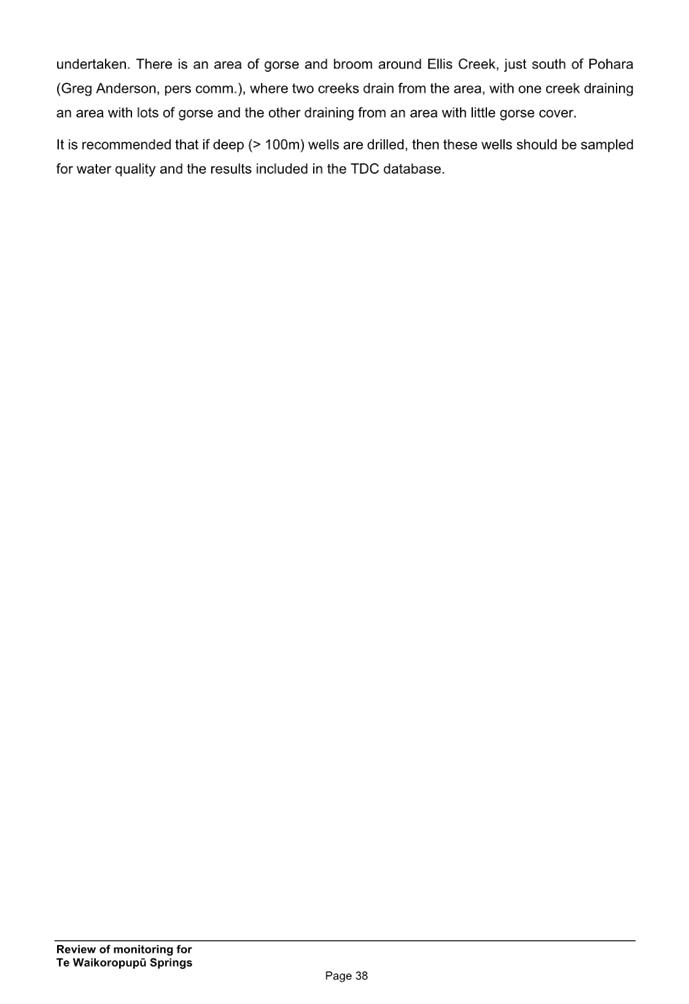
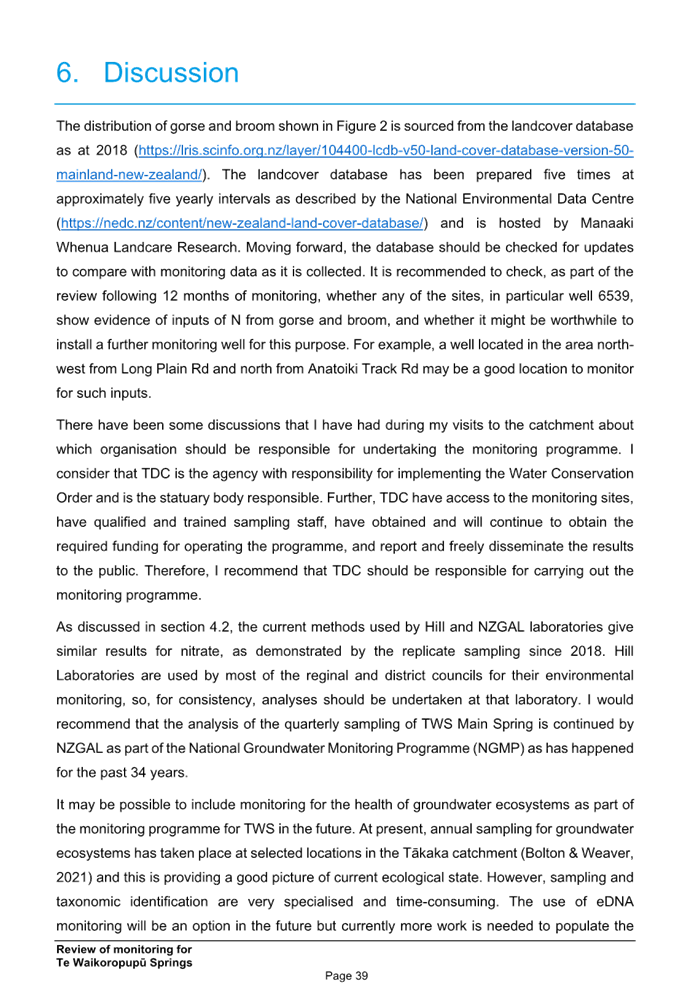









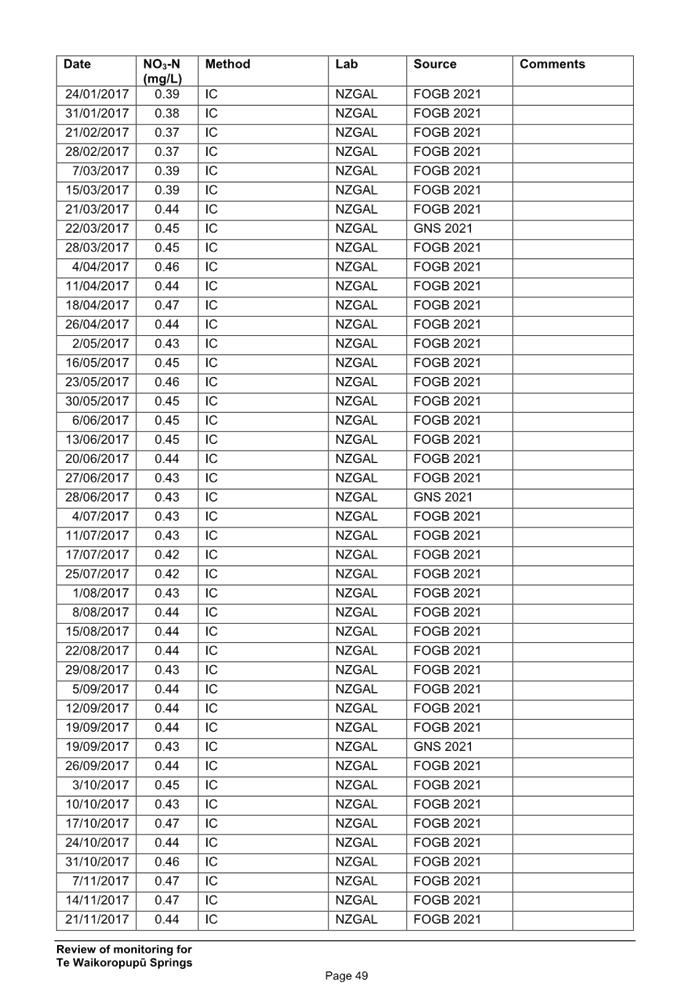
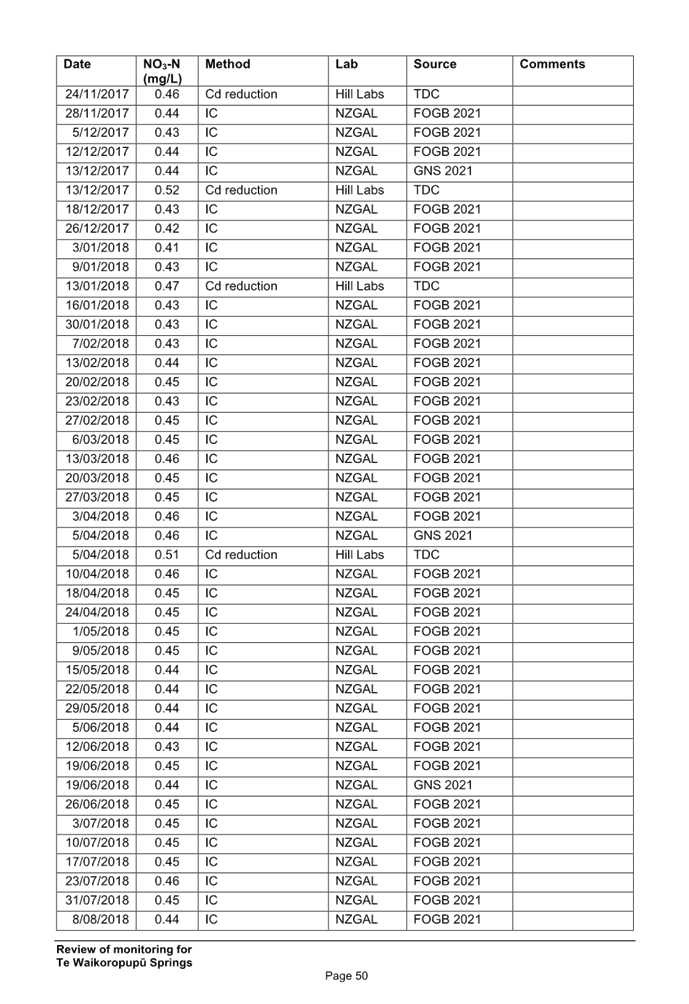
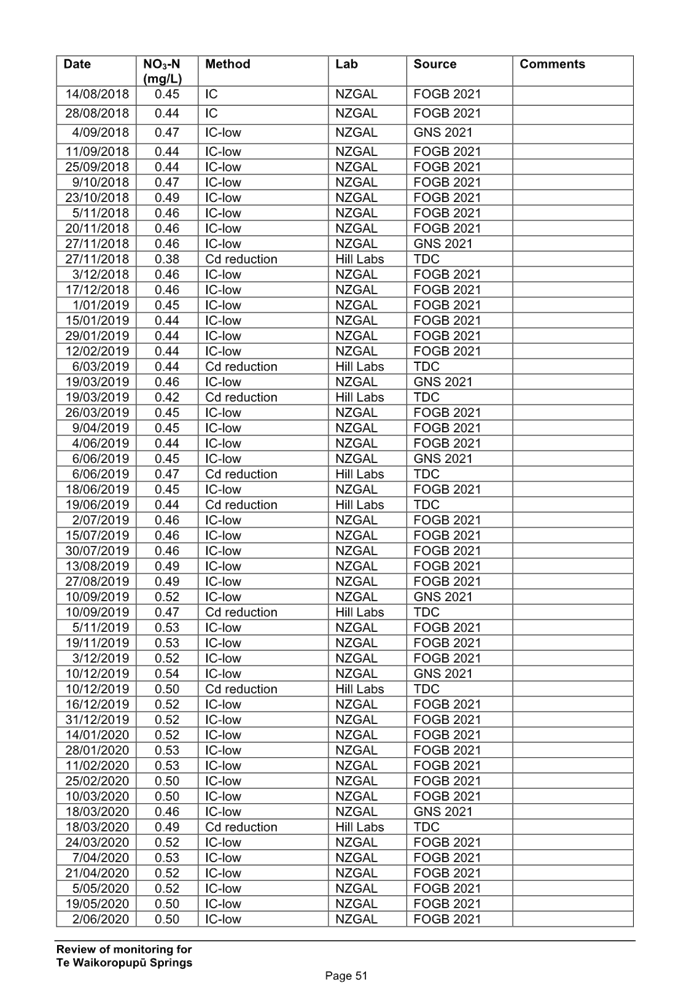
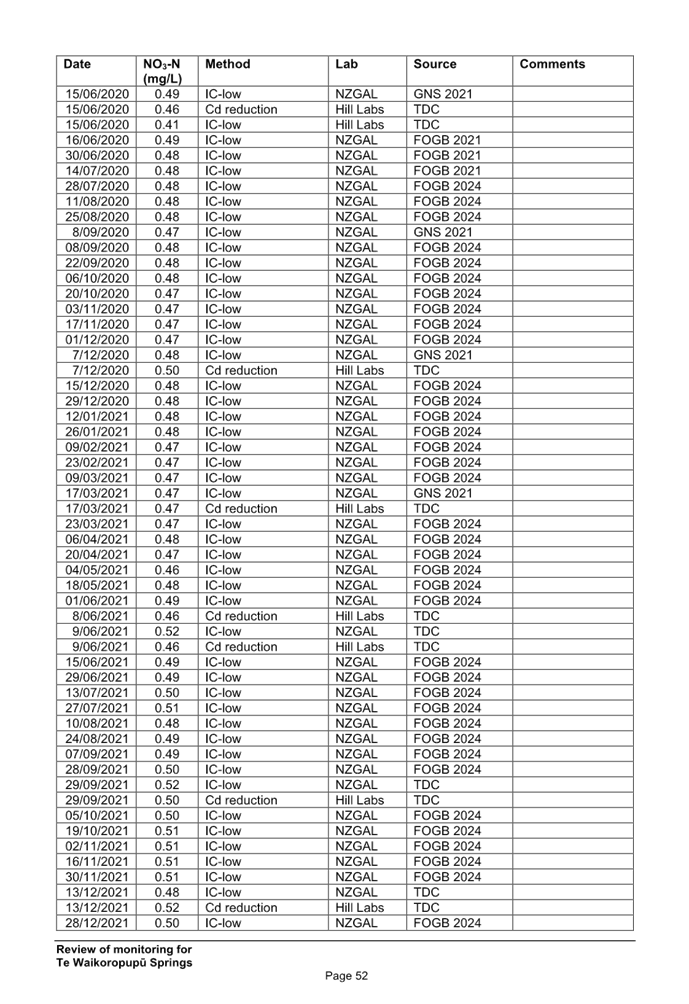
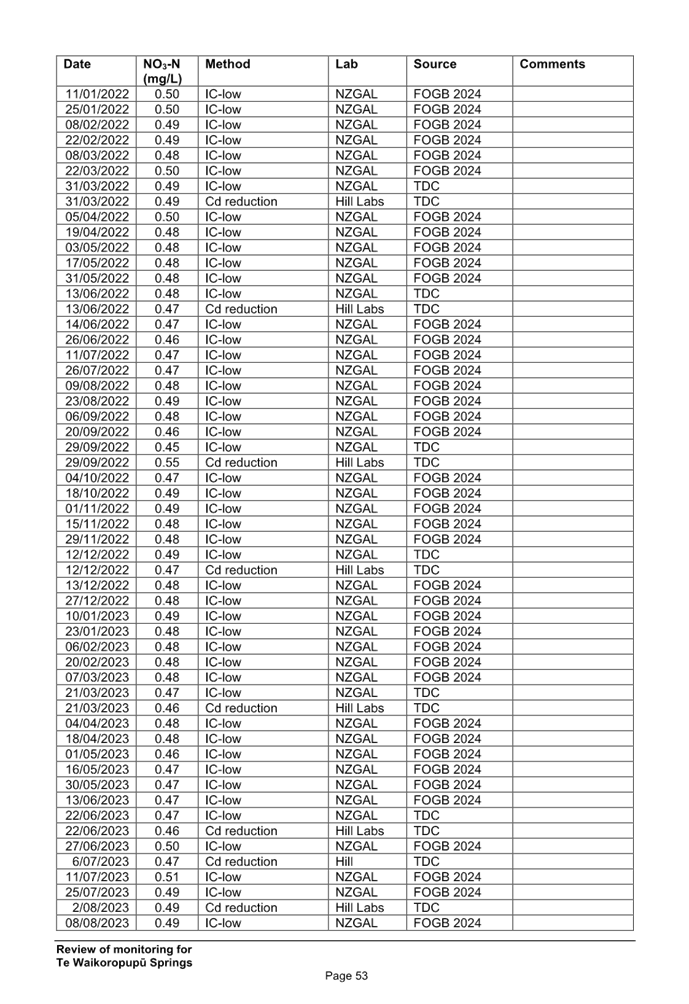
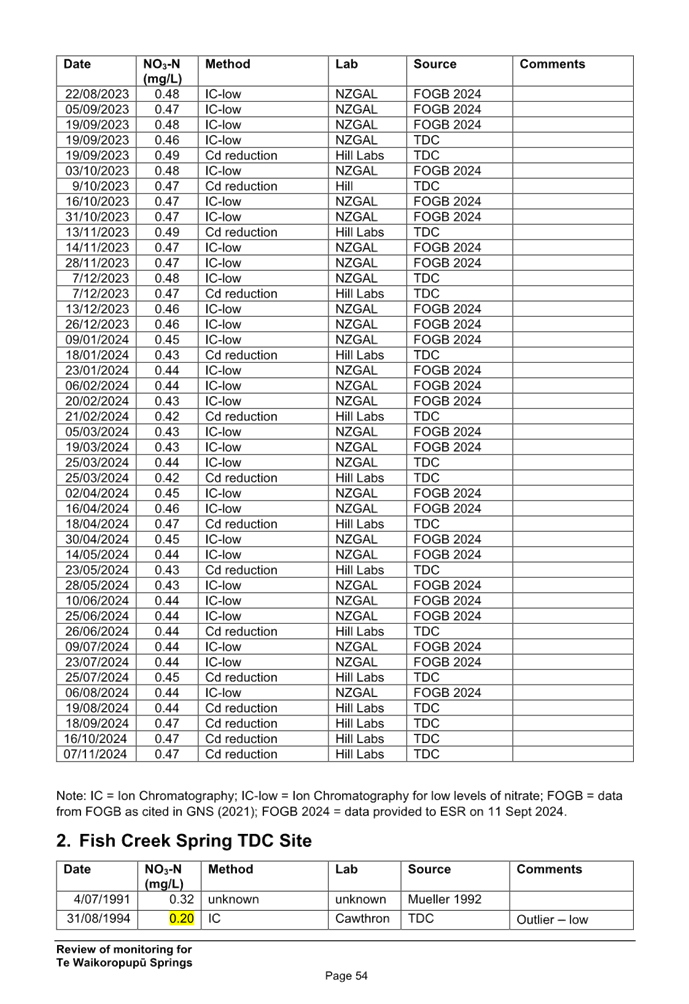
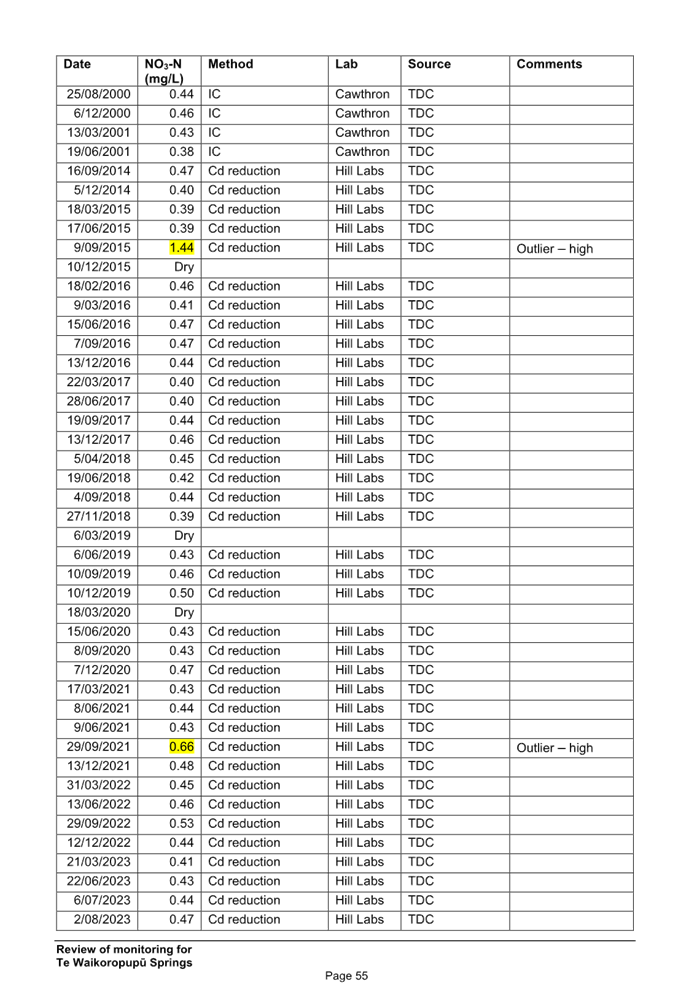
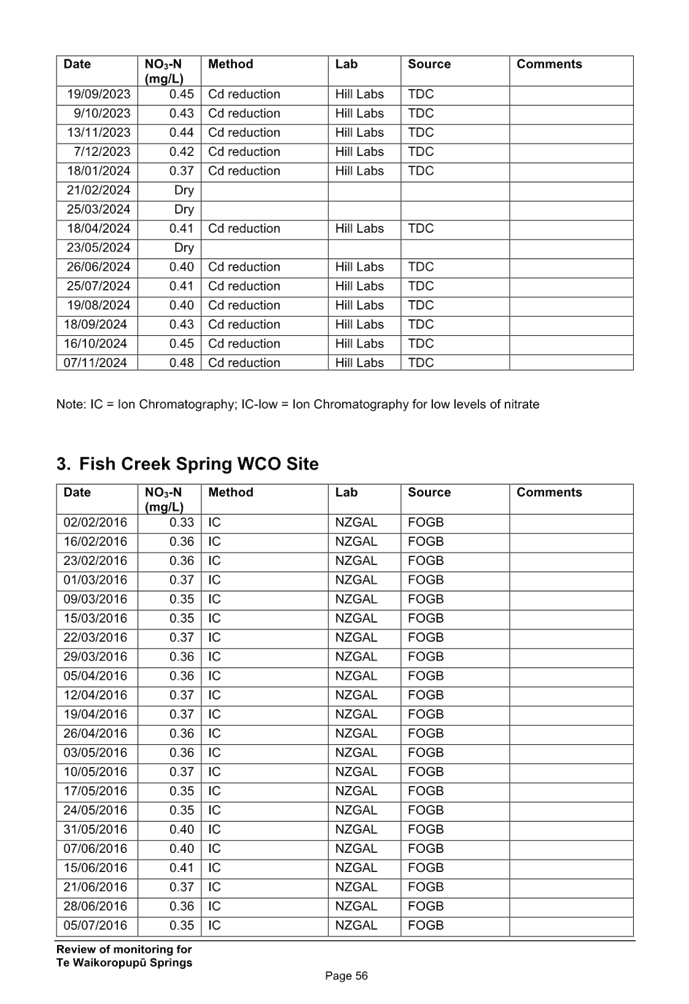
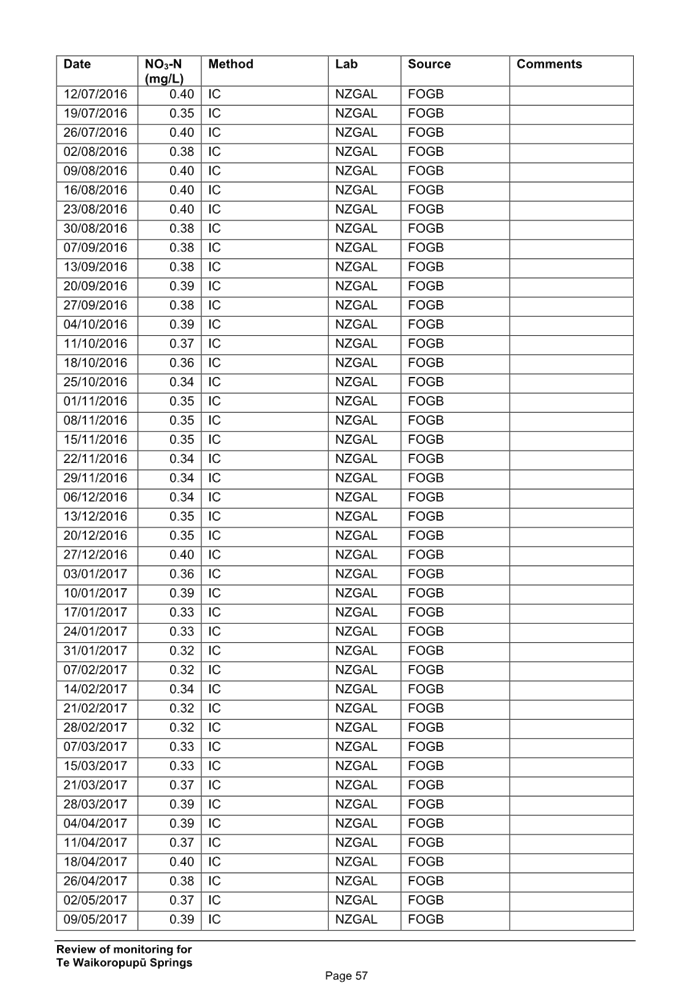
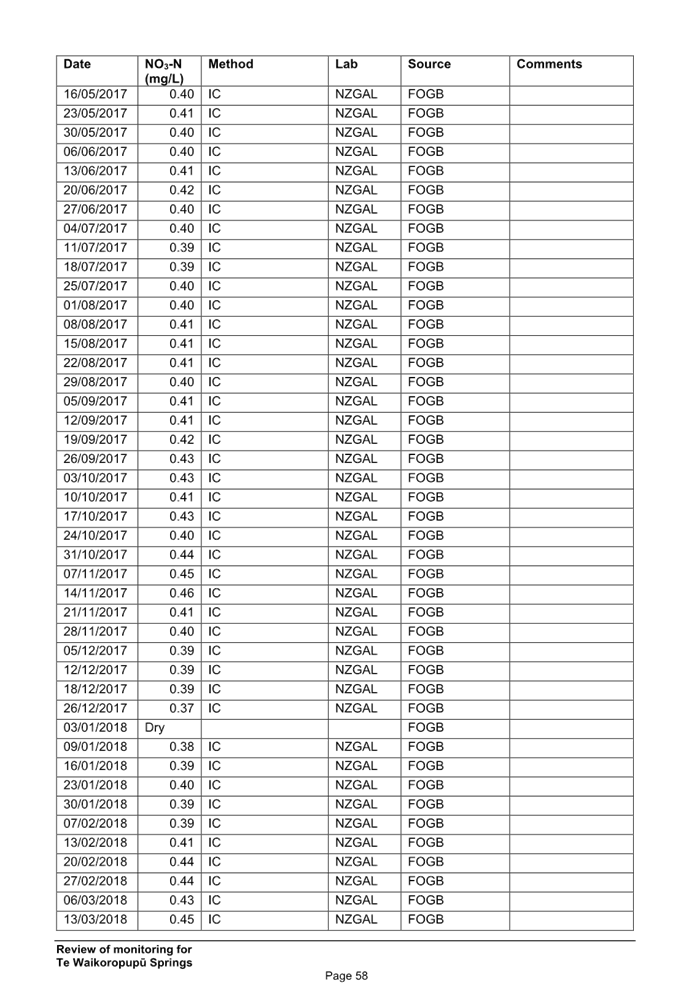
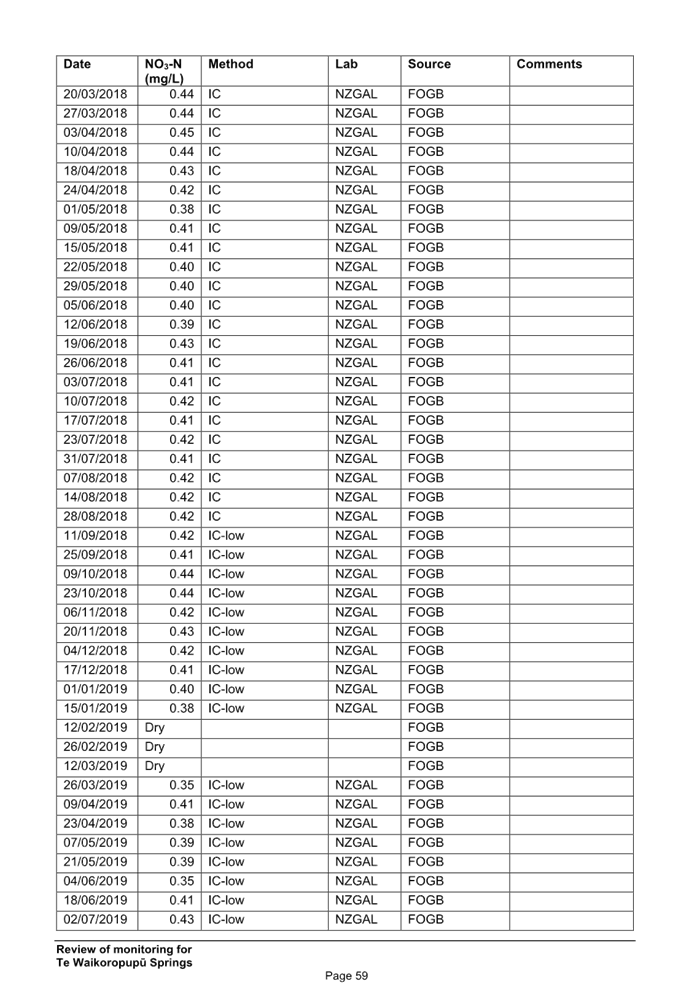
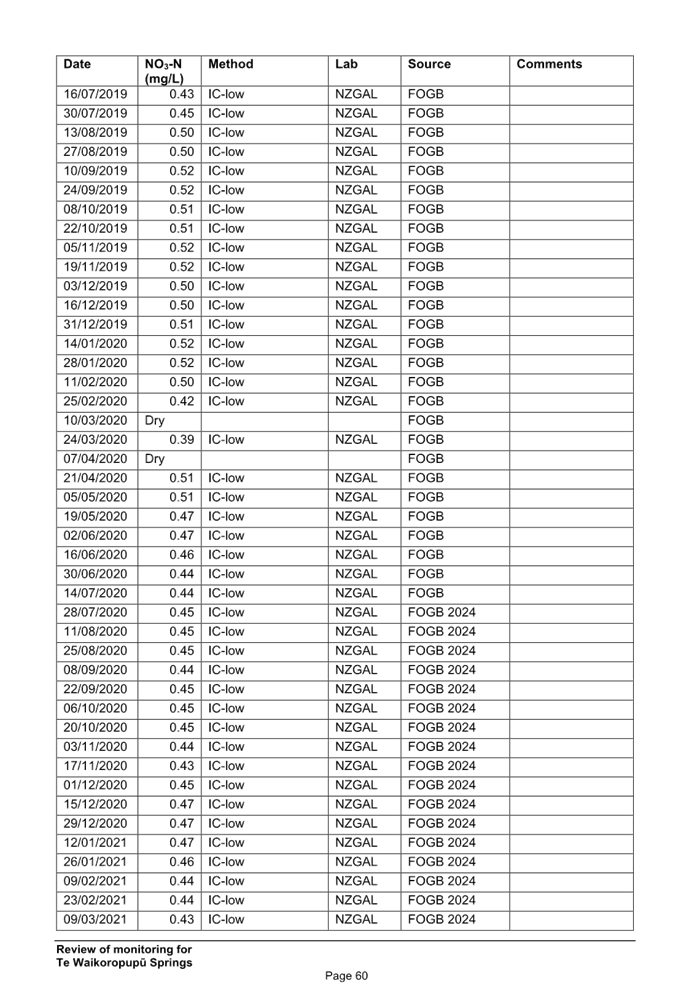
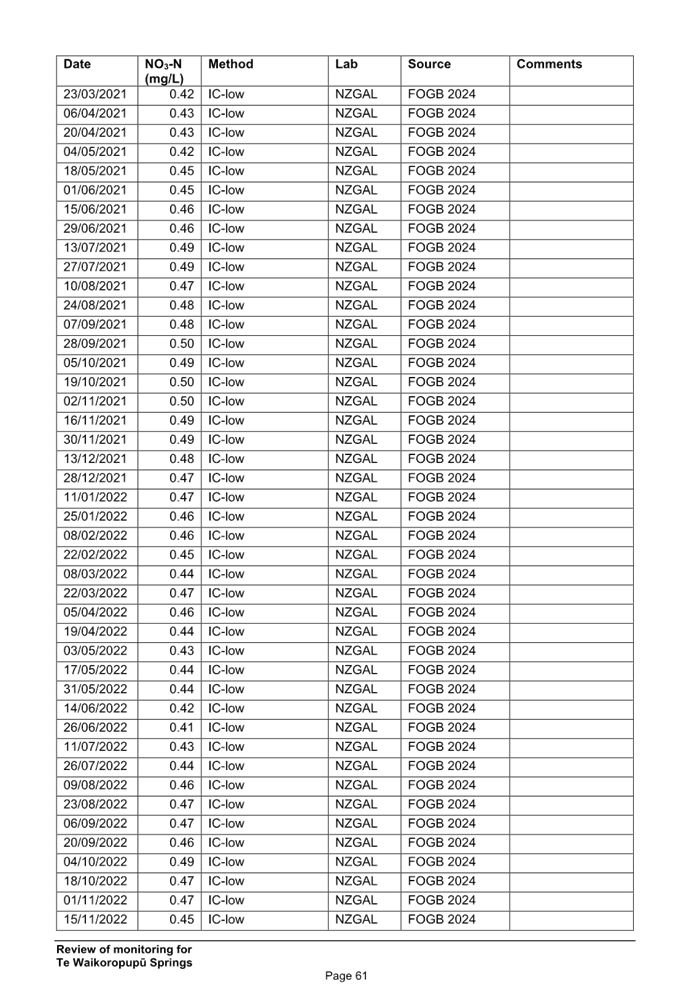
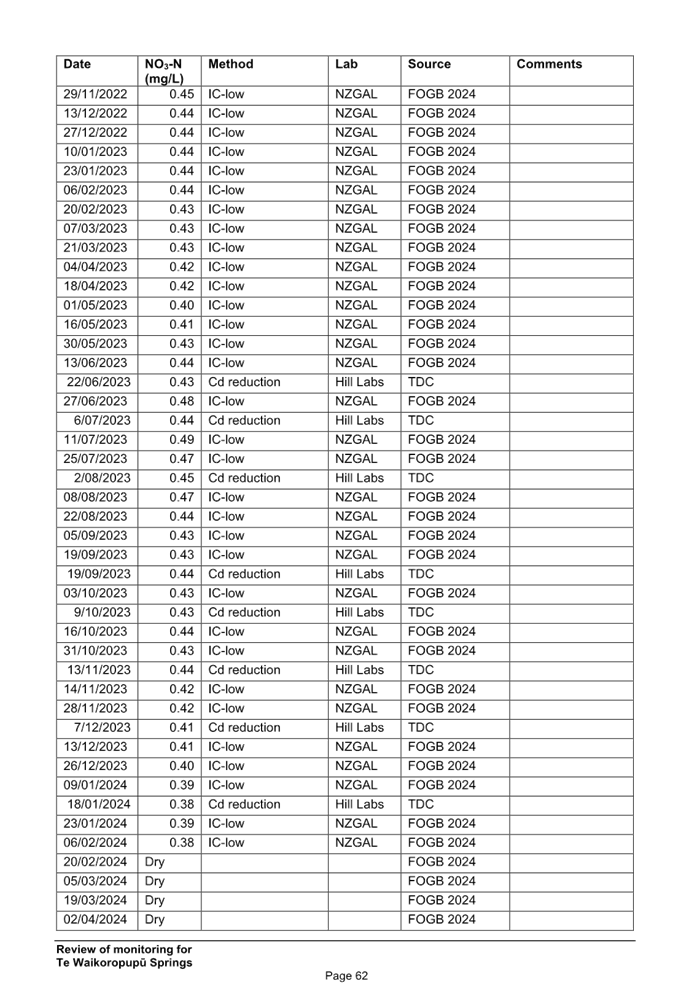
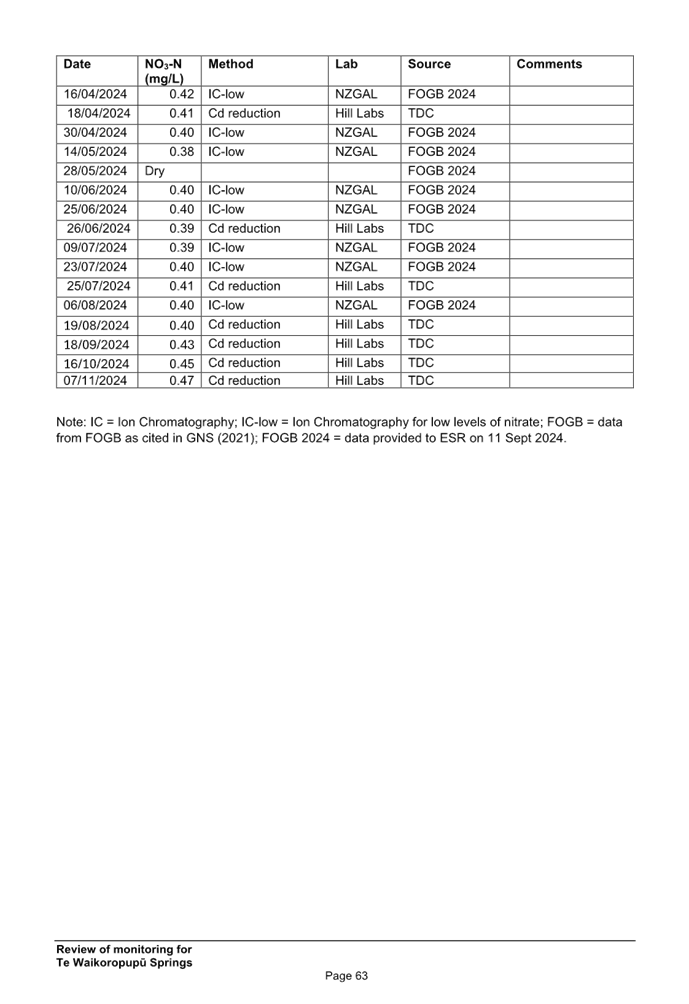

Strategy and Policy Committee Agenda – 19 February 2025
7.3 Heritage Advisory Group Terms of Reference
Decision Required
|
Report
To:
|
Strategy
and Policy Committee
|
|
Meeting
Date:
|
19
February 2025
|
|
Report
Author:
|
John
Ridd, Group Manager - Service and Strategy
|
|
Report
Authorisers:
|
Steve
Manners, Acting Chief Executive Officer
|
|
Report
Number:
|
RSPC25-02-4
|
1. Purpose
of the Report / Te Take mō te Pūrongo
1.1 The
purpose of this report is to agree to a terms of reference to guide the
activities of a yet to be formed Heritage Advisory Group.
2. Summary
/ Te Tuhinga Whakarāpoto
2.1 At
the 3 October 2024 Strategy and Policy Committee it was resolved (resolution
SPC24-10-5) to form a Heritage Advisory Group which would provide guidance to
the Council to inform the Tasman Resource Management Plan (TRMP). This is
in particular reference to those heritage assets identified in Schedule 16.13A
the TRMP.
2.2 It
was further resolved that a terms of reference for that group be brought back
to the Committee for ratification.
2.3 This
report outlines those proposed terms of reference and requests the Committee
approve the recommendation to enable the formation of the group.
3. Recommendation/s
/ Ngā Tūtohunga
That the
Strategy and Policy Committee
1. receives
the Heritage Advisory Group Terms of Reference report, RSPC25-02-4; and
2. approves the Heritage Advisory Group terms of
reference; and
3. confirms it does not wish to have Elected Member
representation on the Heritage Advisory Group.
4.1 During the recent Long Term Plan
process, the Waimea Historical Society (the Society) submitted on a number of
issues relating to the Council’s approach to heritage matters, in
particular, buildings and sites of interest currently excluded from the current
TRMP.
4.2 To this end the formation of a Heritage
Advisory Group was proposed and endorsed by the Strategy and Policy Committee
in October 2024.
4.3 The terms of reference (TOR) of this
group are important to ensure scope and expectations are clearly laid out.
4.4 The Committee should note that the
current national direction being developed around heritage buildings will make
it easier to add or subtract items detailed in District Plans or in Tasman
District Council’s case the TRMP, potentially requiring no plan
change.
4.5 This national direction has not been
issued to date and no timeline is clear at the time of writing.
4.6 The
Society has reached out across the District and there is interest from seven
bodies to be part of that group.
5. Analysis
and Advice / Tātaritanga me ngā tohutohu
5.1 The advice being sought from the
advisory group is to inform planning documents relating primarily to European
settlement of the Tasman District.
5.2 The terms of reference proposed
are as follows:
· represent the whole Tasman region on matters of heritage
relating primarily to European settlement and historical research. Identification, supported by comprehensive
research of heritage sites, buildings and associated historical assets, (which
for clarity under the requirements of the Resource Management Act are required
to be fixed to the ground) that should be put forward for protection in the
Council’s planning documents;
· the advisory group will be formed and remain for the life
of election cycles;
· liaise with local iwi representatives as
appropriate;
· identification and liaison with Heritage NZ (HNZ) around
buildings, sites and other HNZ identified historical assets that may or may not
have been registered;
· act as voluntary advisors to the Council on
matters of heritage sites, buildings and policy;
· independent of the Council, provide update
reports on a six month basis;
· ensure the role of the group is clearly defined
to provide advice to the Council on heritage matters and not to act as
intermediary between the Council and members of the public; and
· advise on recipients for a small grant fund.
5.3 The intent is to provide the Council
with the right level of detail on these matters to allow the Council to make
informed decisions.
5.4 It should be noted that not withstanding
this advice, the Council will make the ultimate decision regarding heritage
issues and may require further information above and beyond this advice.
6.1 The options are outlined in the
following table:
|
Option
|
Advantage
|
Disadvantage
|
|
1.
|
Adopt the terms of reference
|
This will provide the advisory group with
a clear scope and expectations
|
There could be a level of expectation
that cannot be met by the Council with regards to current legislative
constraints. National direction will assist with that.
|
|
2.
|
Do not adopt a terms of reference
|
There is no real advantage to not having
a terms of reference if the group is to be of value to the Council.
|
A tight focus on heritage with a European
settlement focus means the group’s knowledge/research experience can be
used effectively on a singular subject matter.
|
6.2 Option 1 is recommended.
7.1 The Resource Management Act 1991 (RMA) process
will need to be followed.
8. Iwi
Engagement / Whakawhitiwhiti ā-Hapori Māori
8.1 The terms of reference does outline
engagement with iwi partners in research as appropriate.
8.2 It is an expectation that any research
carried out takes into account all history pertaining to the subject
matter.
9. Significance
and Engagement / Hiranga me te Whakawhitiwhiti ā-Hapori Whānui
9.1 As outlined in the following
table, we consider this activity overall to be of low significance.
|
|
Issue
|
Level of
Significance
|
Explanation of
Assessment
|
|
1.
|
Is there a high level
of public interest, or is decision likely to be controversial?
|
Low
|
The public interest
will generally pertain to specific property and property owners. There
are due processes to follow before any change can occur.
|
|
2.
|
Are there impacts on
the social, economic, environmental or cultural aspects of well-being of the
community in the present or future?
|
No
|
|
|
3.
|
Is there a
significant impact arising from duration of the effects from the decision?
|
No
|
|
|
4.
|
Does the decision
relate to a strategic asset? (refer Significance and Engagement Policy for
list of strategic assets)
|
No
|
|
|
5.
|
Does the decision
create a substantial change in the level of service provided by Council?
|
No
|
|
|
6.
|
Does the proposal,
activity or decision substantially affect debt, rates or Council finances in
any one year or more of the LTP?
|
No
|
|
|
7.
|
Does the decision
involve the sale of a substantial proportion or controlling interest in a CCO
or CCTO?
|
No
|
|
|
8.
|
Does the
proposal or decision involve entry into a private sector partnership or
contract to carry out the deliver on any Council group of activities?
|
No
|
|
|
9.
|
Does the proposal or
decision involve Council exiting from or entering into a group of
activities?
|
No
|
|
|
10.
|
Does the proposal
require particular consideration of the obligations of Te Mana O Te Wai
(TMOTW) relating to freshwater or particular consideration of current
legislation relating to water supply, wastewater and stormwater
infrastructure and services?
|
No
|
|
10. Communication
/ Whakawhitiwhiti Kōrero
10.1 There has been no communication carried out to date
on this matter. The formation of the advisory group will be of minor
interest to the wider community. Any recommendations will need to follow
the Council’s due process and the Council will lead any communications.
11. Financial
or Budgetary Implications / Ngā Ritenga ā-Pūtea
11.1 Low – the group is voluntary and as such
receive no meeting remuneration.
12.1 None foreseen.
13. Climate
Change Considerations / Whakaaro
Whakaaweawe Āhuarangi
13.1 None foreseen.
14. Alignment
with Policy and Strategic Plans / Te Hangai ki ngā aupapa Here me ngā
Mahere Rautaki Tūraru
14.1 The Heritage Advisory Group will support and thus
align to preparing any Tasman Resource Management Plan (TRMP) plan change.
15. Conclusion
/ Kupu Whakatepe
15.1 The Strategy and Policy Committee has, at a
previous meeting, agreed to the formation of a Heritage Advisory Group.
15.2 The focus of the advisory group is district
European heritage buildings, sites and associated assets.
15.3 A clear terms of reference will focus the
group’s work and provide support to staff when reviewing this section of
the TRMP. It will also set clear expectations as to the role of the
group.
16. Next
Steps and Timeline / Ngā Mahi Whai Ake
16.1 The next steps, if the Committee agrees, is to form the group and
create a meeting schedule.
16.2 Staff suggest creating an independent advisory board and do not
recommend any elected member representation.
16.3 The Committee may disagree and may wish to have elected member
representation in the group.
Nil
Strategy and
Policy Committee Agenda – 19 February 2025
7.4 Waimea Inlet Action Plan Annual Progress
Report
Information Only - No Decision
Required
|
Report
To:
|
Strategy
and Policy Committee
|
|
Meeting
Date:
|
19
February 2025
|
|
Report
Author:
|
Anna
Gerraty, Senior Community Policy Advisor; Cat Budai, Community Policy Advisor
|
|
Report
Authorisers:
|
Dwayne
Fletcher, Strategic Policy Manager; John Ridd, Group Manager - Service and
Strategy
|
|
Report
Number:
|
RSPC25-02-5
|
1. Purpose
of the Report / Te Take mō te Pūrongo
1.1 This report
informs the Council of progress towards implementing the Waimea Inlet Action
Plan during the 2024 calendar year.
2. Recommendation/s
/ Ngā Tūtohunga
That the Strategy and Policy Committee
1. receives the Waimea Inlet Action Plan Annual Progress Report, RSPC25-02-5.
3. Summary
/ Te Tuhinga Whakarāpoto
3.1 In August 2023 (RSPC23-08-2), the
Committee agreed that the Council would lead or assist with specific
actions/targets listed in the updated ‘Waimea Inlet Action Plan
2023-2026’ (Action Plan). The Action Plan is designed to implement the
Waimea Inlet Management Strategy (Strategy), to which the Council is a
signatory. The Strategy and Action Plan is a non-statutory document aimed at
maintaining and improving the health of the Waimea Inlet.
3.2 The Council is a member of the Waimea
Inlet Coordination Group (the Group) that coordinates the review,
implementation and monitoring of the Strategy and Action Plan.
3.3 In November each year, the Group
produces an annual report, summarising progress made in implementing the Action
Plan. The progress report for the 2024 calendar year is appended as Attachment
1.
3.4 In 2024, good
progress was made in implementing the Action Plan. Highlights include salt
marsh restoration at Rough Island, the continued enhancement of marsh bird
habitat at Waimea River Delta and banded rail and fernbird surveys indicating
population increases.
4.1 The Waimea Inlet is the largest
semi-enclosed inlet in the South Island and has international and national
importance as a site for migratory birds. The Inlet lies within both Tasman and
Nelson regions.
4.2 The initial Strategy was developed in
2010 to coordinate a cross-regional approach to the care of the Inlet. The
Council is a signatory to the Strategy, along with Nelson City Council (NCC),
the Department of Conservation (DOC), Fish & Game, and Te Tauihu iwi. The
Action Plan is designed to implement the Strategy.
4.3 The Group was formed in 2017 to
“identify, prioritise, and coordinate the actions needed to achieve
implementation of the Strategy and collate these into a proposed Action
Plan.” Cr Ellis is appointed as Council’s elected member representative
on the Group, with Cr Kininmonth as an alternate. Staff across different
departments of the Council actively participate in the work of the Group.
4.4 Current members of the Group also
include representatives from NCC (Cr Sanson and staff), DOC, Waimea Inlet Forum
(WIF), Tasman Environmental Trust (TET), Tasman Bay Guardians, Te Ātiawa,
Ngāti Tama, Ngāti Rārua, Ngāti Kōata, Ngāti Toa,
Ngāti Kuia and Ngāti Apa.
4.5 Members of the Group commit to specific
actions for their organisation. All targets and actions have a lead
organisation responsible for progressing the actions.
4.6 All eight Te Tau Ihu iwi have an open
invitation to become signatories to the Strategy, to appoint representatives to
the Group and to participate in the development, implementation, review and
monitoring of the Action Plan. They have been kept informed of progress
throughout the Action Plan’s development and implementation. Seven iwi
have now engaged in the work of the Group, but Rangitāne has not had the
time/capacity to engage at this stage.
4.7 The Group meets quarterly, with
administrative support provided by Tasman District Council staff. The Council
works collaboratively with the Group to implement the Action Plan and give
effect to the Strategy.
4.8 The initial Action Plan was finalised at
the end of 2018. A review of the Strategy and Action Plan (including public
consultation on a draft version), led by an external consultant, was completed
in June 2023. The Committee adopted the revised ‘Waimea Inlet Management
Strategy 2050 and Action Plan 2023 to 2026’ in August 2023.
4.9 The intention is that all Group members
work together to achieve the Action Plan’s targets. When unbudgeted
funding is required, external funding will be sought. The Strategy and Action
Plan is an ‘investment ready’ document that external (i.e.
non-Council) funders can refer to when considering funding applications.
4.10 Collectively the Group has secured over $3 million
of government funding to assist with implementation of the Action Plan. The MfE
funding of $1.6 million secured in 2020, for projects that Tasman District
Council is delivering, will end midway through 2025. This will impact our
ability to deliver upon the Action Plan going forward, with the rate of
progress anticipated to slow down in future.
5.1 An analysis of progress made on action
points during the 2024 calendar year shows that 13 are complete/on track, 20
are in progress and 11 are delayed.
5.2 The plan has an
action to provide ongoing support for Project Moturoa. This project has been
superseded, with NMIT weaving the Te Ao Māori strands
into their Kaitiaki Whenua Trainee Ranger programme instead. Two planting days
with these students have taken place, focusing on restoring a natural coastal
forest sequence and coast care plantings.
5.3 A comprehensive
list of threatened and locally significant species and their requirements has
been prepared and mapped for Tasman’s coastal environment.
5.4 Ngāti Tama
has partnered with Cawthron to undertake seagrass restoration research and
other work in the Inlet. NCC will be contributing funding to the 2024-2025
components of the ‘Restore the Meadows’ campaign, focused on
seedling growth trials.
5.5 Tasman
Environment Trust has undertaken further fernbird and banded rail surveys to
monitor the impact of their Battle for the Banded Rail trapping programme.
Their trap network has expanded further during the past year. The 2024 survey
shows an increase in evidence of banded rail in previously sited areas and in
two new areas. The fernbird survey has also shown an increase in
population.
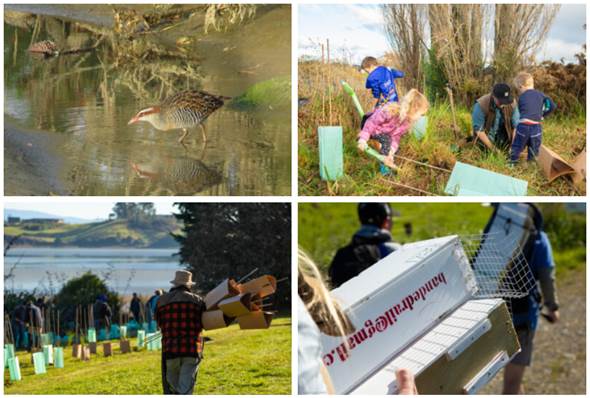
Battle for the
banded rail project
5.6 Data from the McArthur et al
report has informed the Council’s Dog Bylaw review to encourage
appropriate use of the Inlet edge and reserves by dog walkers. The now adopted
bylaw prohibits dogs from many locations along the western edge of Waimea Inlet
and continues to prohibit dogs on Moturoa/Rabbit Island.
5.7 The target to enhance three hectares of
marsh bird habitat in the Waimea River Delta by 30 June 2025 as part of
the Waimea Inlet Enhancement Project is on track and has already been exceeded,
with 3.5 hectares enhanced since early 2022. Two phases of earthworks (2022 and
2023) have created open water areas and re-wet portions of the site, while over
10,000 native plants have been planted and targeted weed control carried out.
Monitoring for marsh birds began in September 2024.
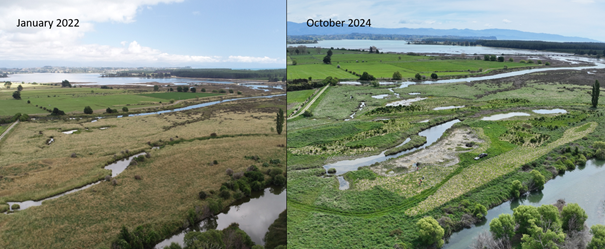
Waimea Delta
wetland enhancement project
5.8 Surveys and control of pest plants such
as Spartina continue to be undertaken by both DOC and Project De-Vine
(through the Protecting Flora Jobs for Nature project, overseen by the
Council). Control of species such as Jellybean Ice Plant, Tamarisk and other
estuarine pest plants is also well underway across the Inlet. A report by Salt
Ecology has assessed the salt marsh restoration opportunities. This is being
worked through where budget and landowner interest is available.
5.9 The target for 10% of urban and
industrial stormwater and effluent discharges to meet ANZECC (2000) ISQG low
sediment toxicity criteria within 50m of discharge outfalls by 2050 is
progressing. An estuary impact study was conducted by Tasman District Council
at stormwater outfalls in Motueka and Māpua, with results showing
compliance with guidelines in Māpua, except for cadmium (Cd) and nickel
(Ni), likely due to local geology. Ongoing monitoring in Richmond includes dry
and wet weather conditions, alongside industrial outfalls. Ten litter traps
have been installed in Richmond CBD, and a Jellyfish filter is treating runoff
from the Poutama industrial area. Stormwater Catchment Management Plans (CMPs)
for Brightwater/Wakefield and Māpua are being drafted.
5.10 Sediment quality monitoring by NCC in 2022 showed
lead (Pb) exceeding guidelines at three of 23 sites and zinc at two of 23
sites, though overall metal contaminants are declining. Wastewater and
stormwater programmes are addressing leaks and infiltration. A July 2023
sediment survey at Waimea Inlet discharge outlets found elevated mud content at
nine sites but low heavy metal concentrations overall, except for naturally
occurring nickel at multiple sites.
5.11 Salt marsh restoration is ongoing at several sites,
including the Rough Island Embayment, with further planting of salt marsh
species to be undertaken at Research Orchard Road and Estuary Place.
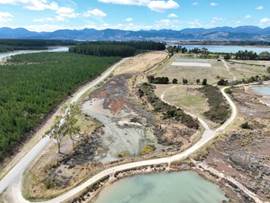
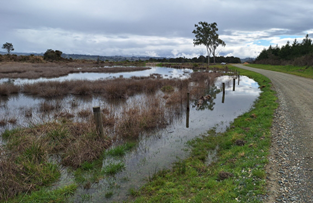
Rough Island Embayment pre- and post-culvert enlargement
5.12 NCC is conducting
six-monthly photopoint monitoring of the chenier ridge planting plots and
planting new plots for salt marsh restoration.
Delays and Challenges
5.13 NCC completed its State of the Environment Report
and macroinvertebrate community index report for stream
ecosystem health. This showed that the four streams monitored at the coast are
all degraded, impacted by deposited fine sediment and loss of habitat from
flooding and removal of flood debris, woody debris and vegetation.
5.14 No progress has been made
on preparing a unified animal pest control plan as per action 2.2.3. Specific
pests are controlled within the Regional Pest Management Plan (RPMP) Waimea
Inlet site-led programme where they meet the cost-benefit analysis for inclusion.
5.15 Progress toward ensuring
contaminant loads in the eight monitored waterways discharging to the Inlet
remain within safe levels by 1 January 2025 is partly reliant on the Freshwater
Farm Plan Regulations, which have been paused for review by central government.
The outcome of the review is expected by mid-2025, creating uncertainty around
when the regulations will apply locally. Meanwhile, Landcare Trust has
generated strong interest among landowners for establishing a Waimea Catchment
group, with discussions underway on forming a broader collective to represent
potential sub-catchment groups.
6.1 The majority of
actions are either in progress, on track or complete, with steady progress
towards targets being achieved throughout the year.
6.2 Attachment 1
will be published online at Waimea
Inlet Management Strategy and Action Plan | Tasman District Council alongside progress reports from previous years.
|
1.⇩
|
2024
Annual report on progress implementing Waimea Inlet Action Plan
|
89
|
Strategy and
Policy Committee Agenda – 19 February 2025
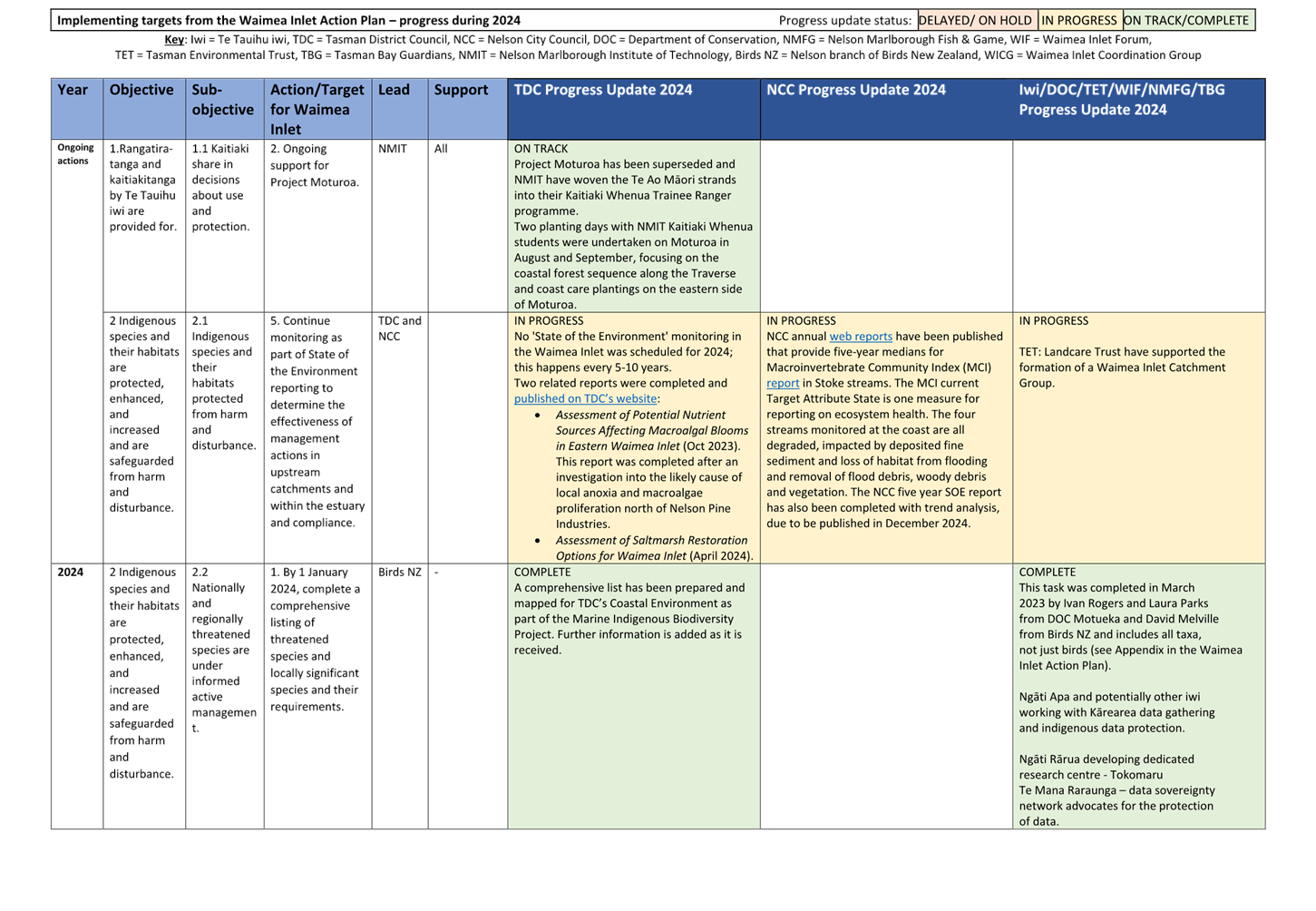
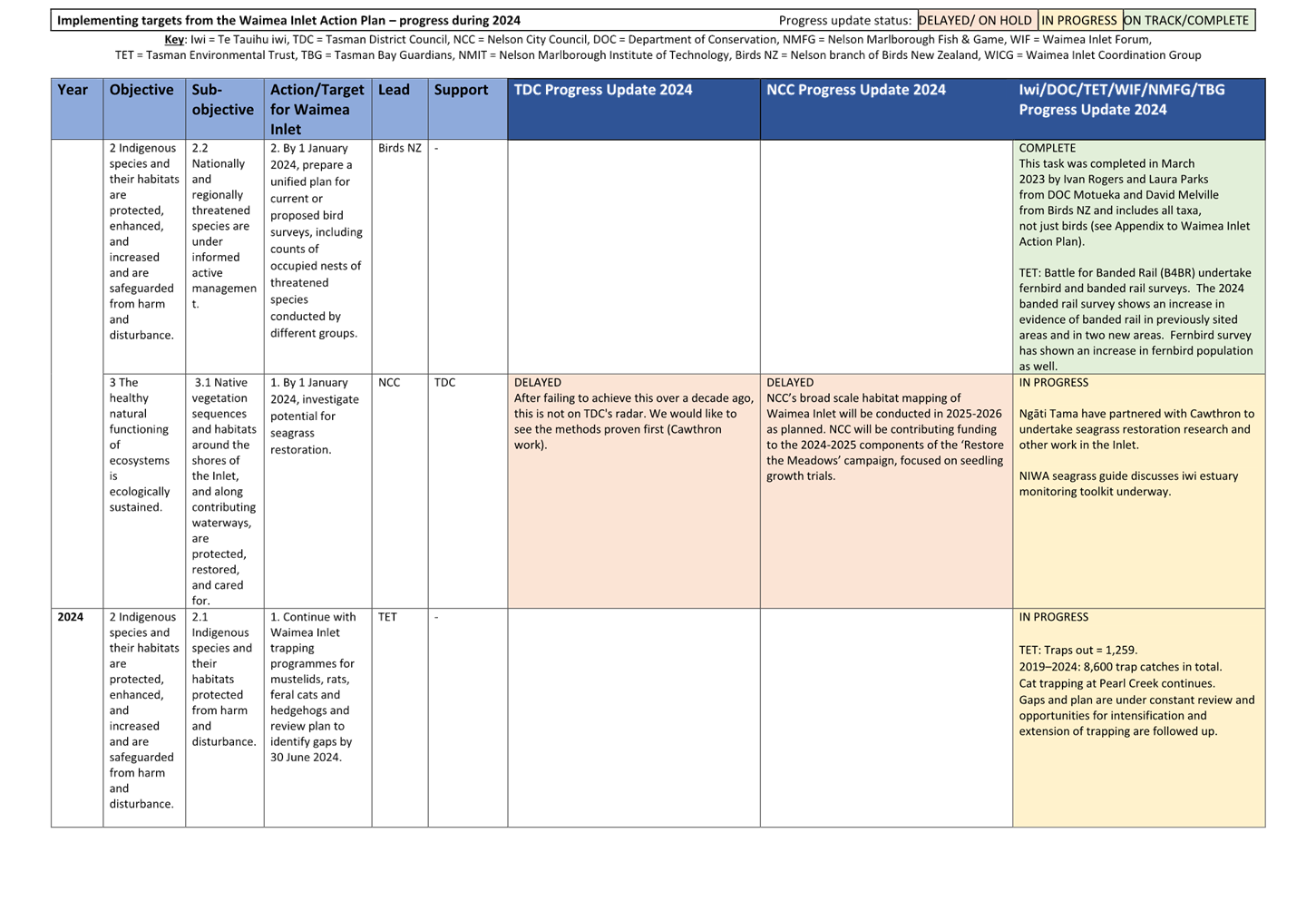
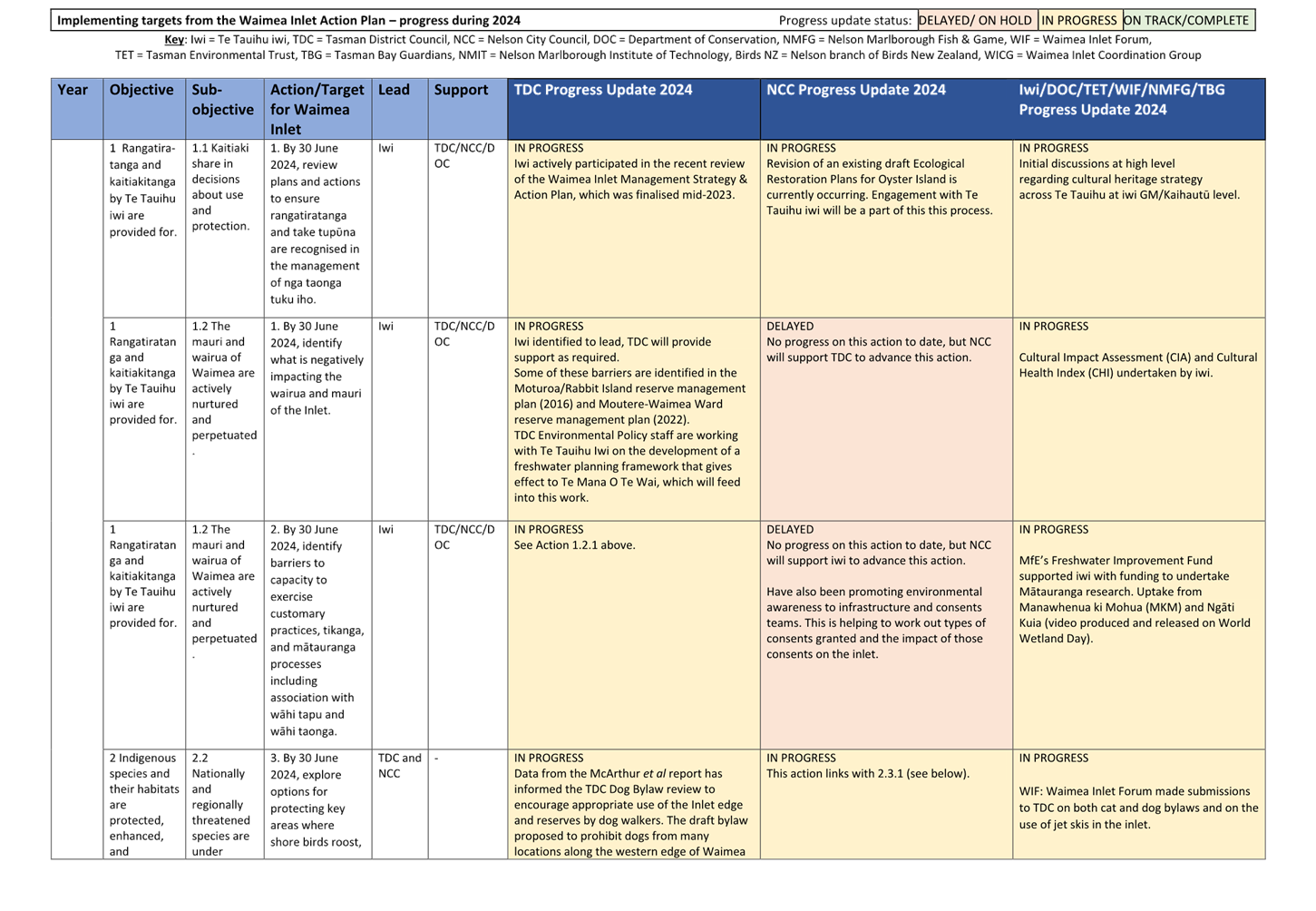
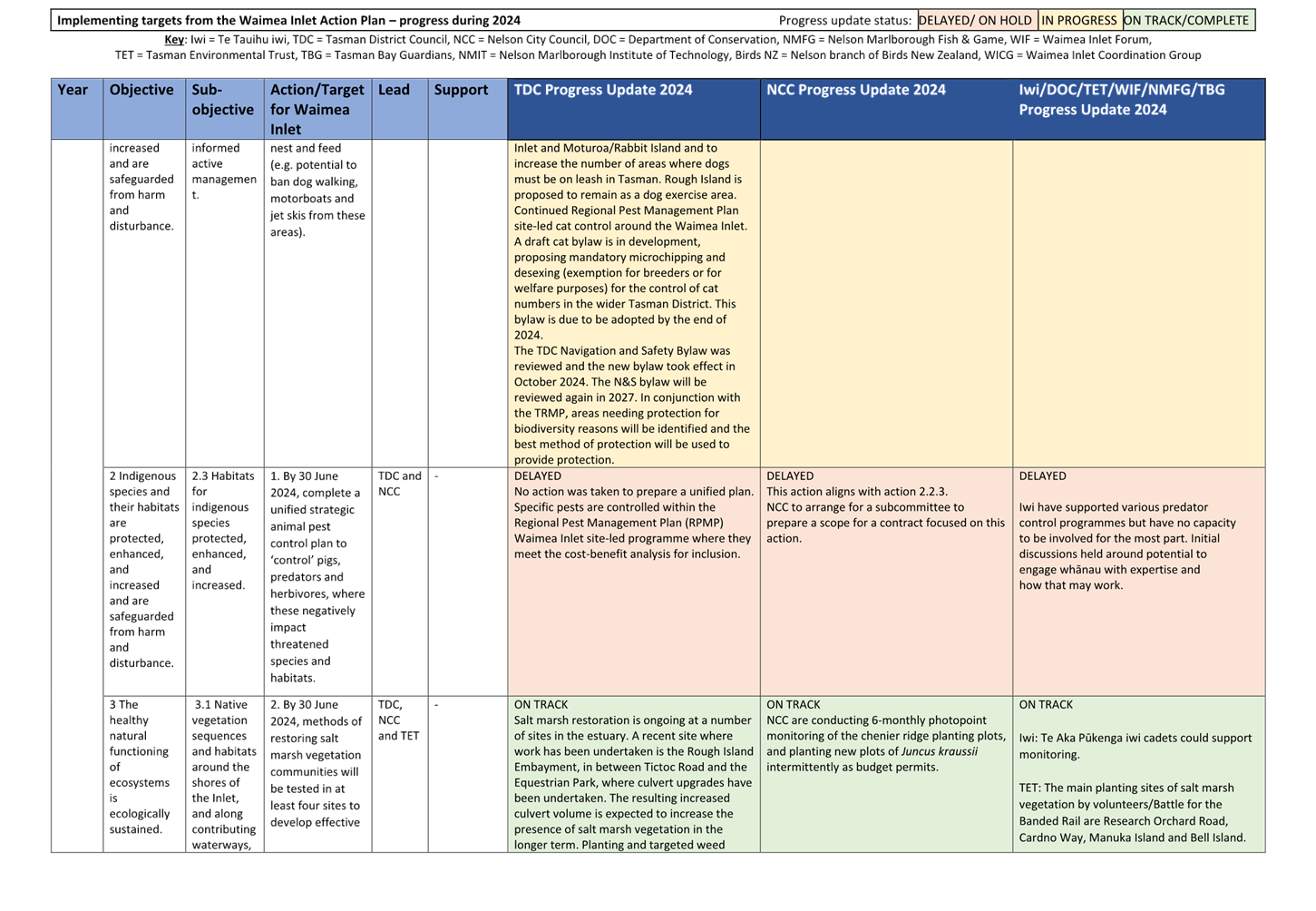
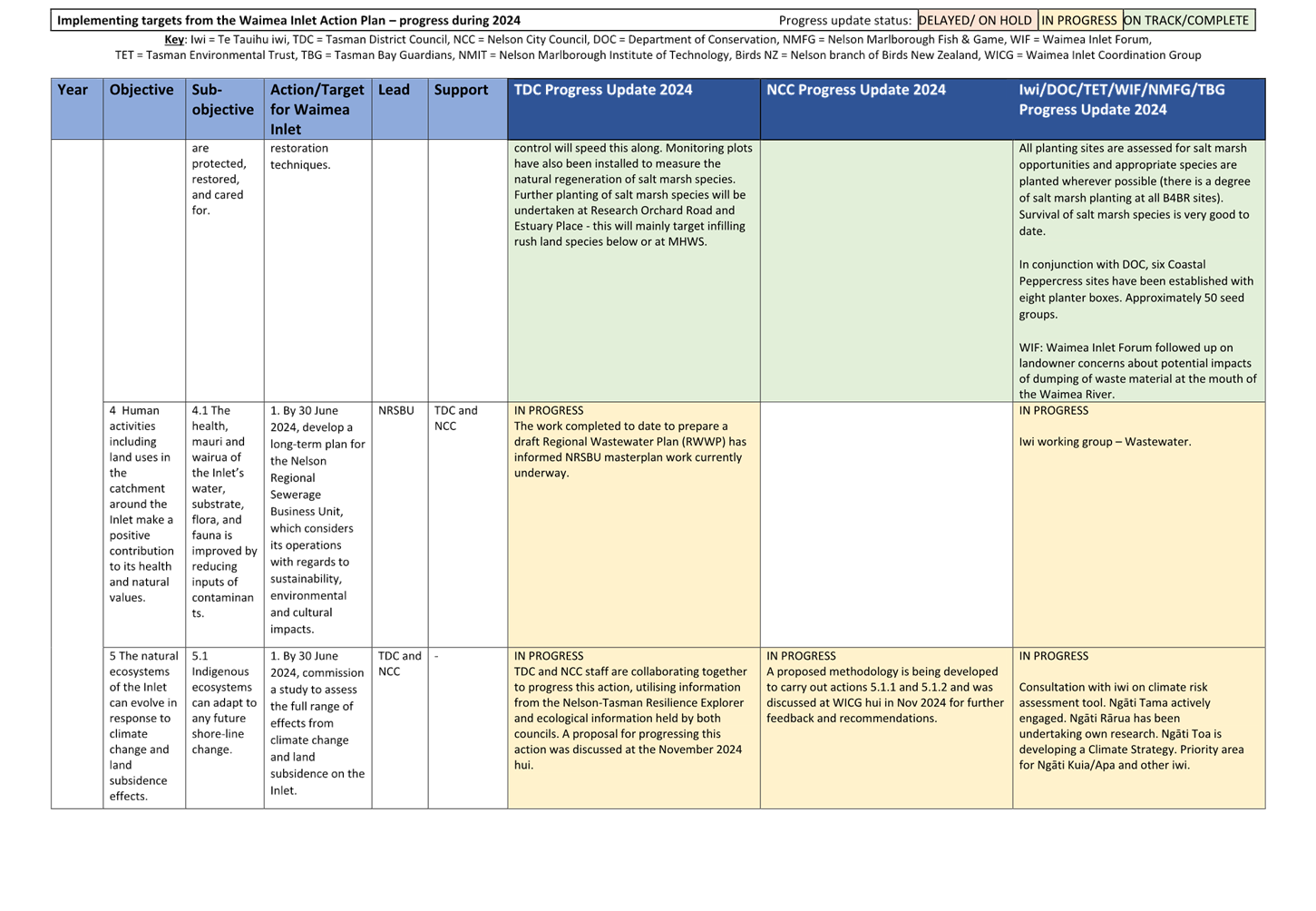
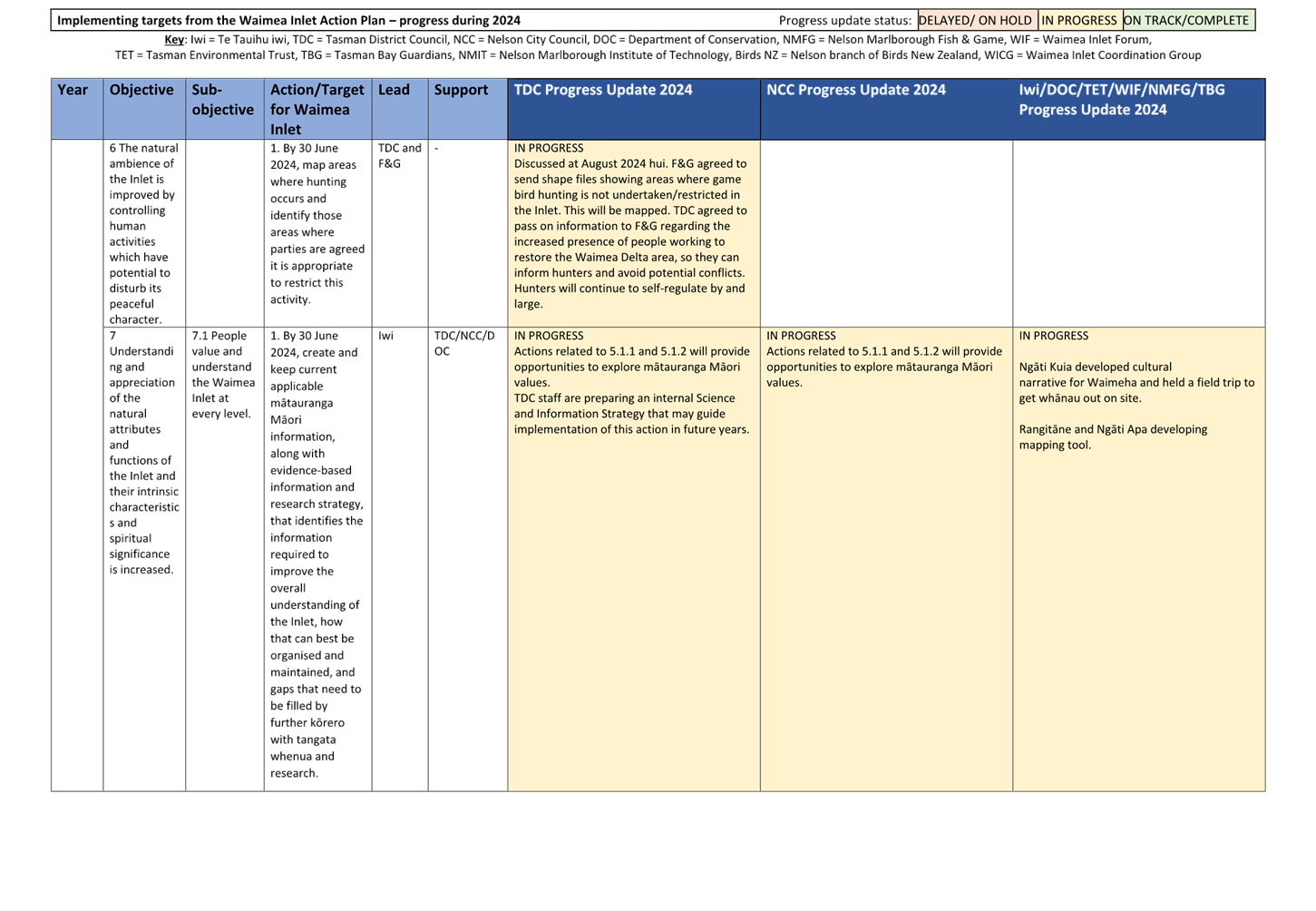
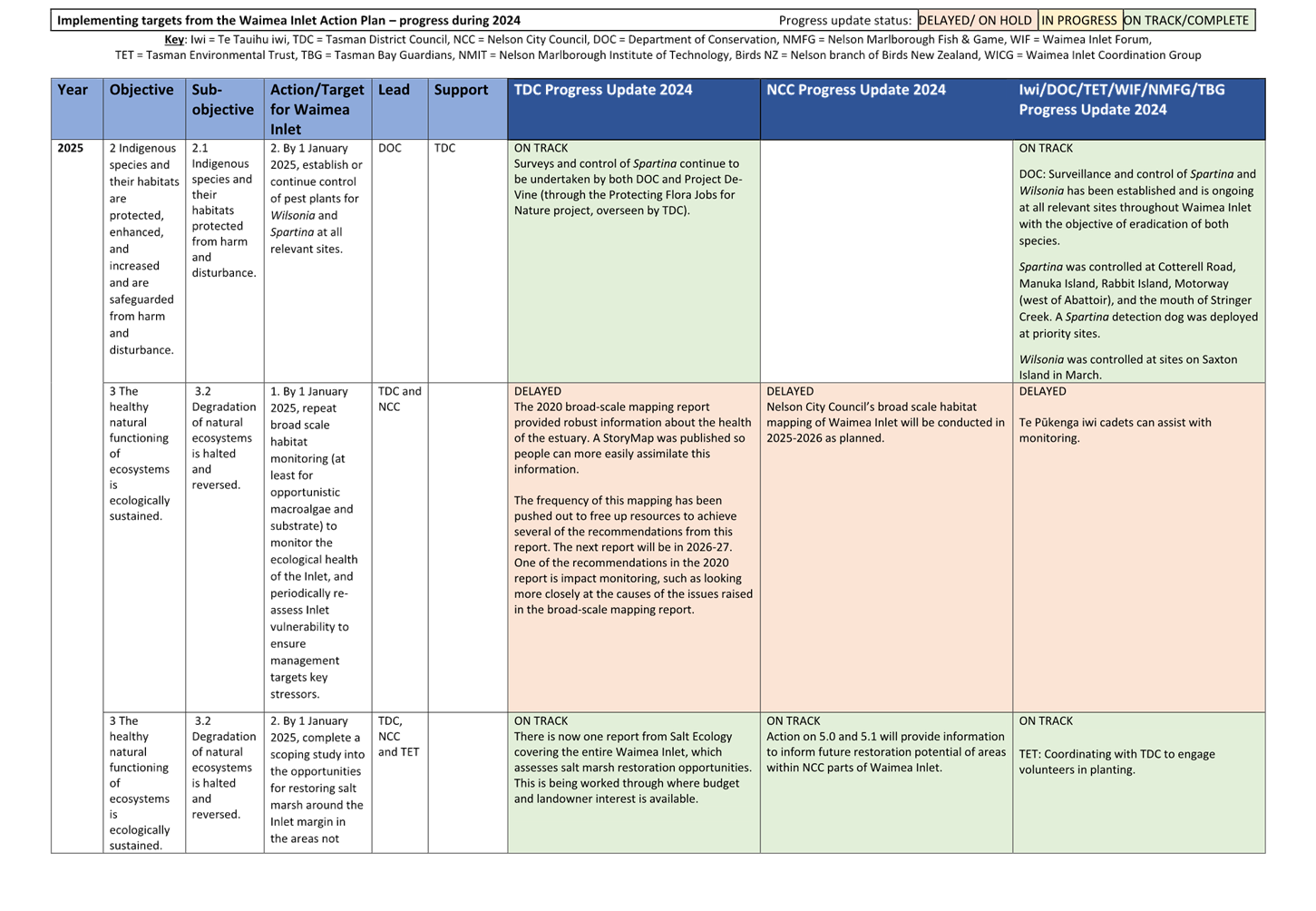
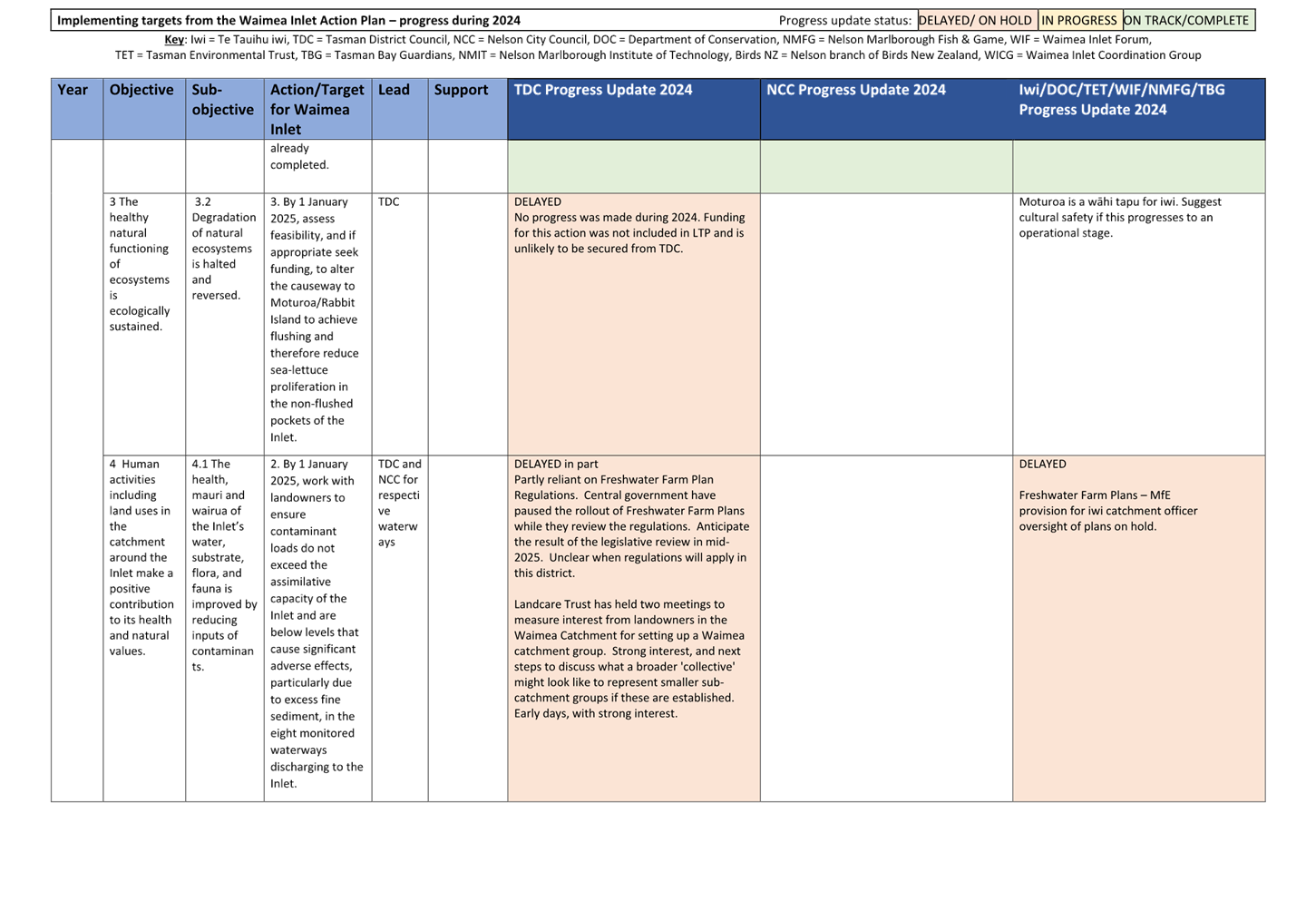
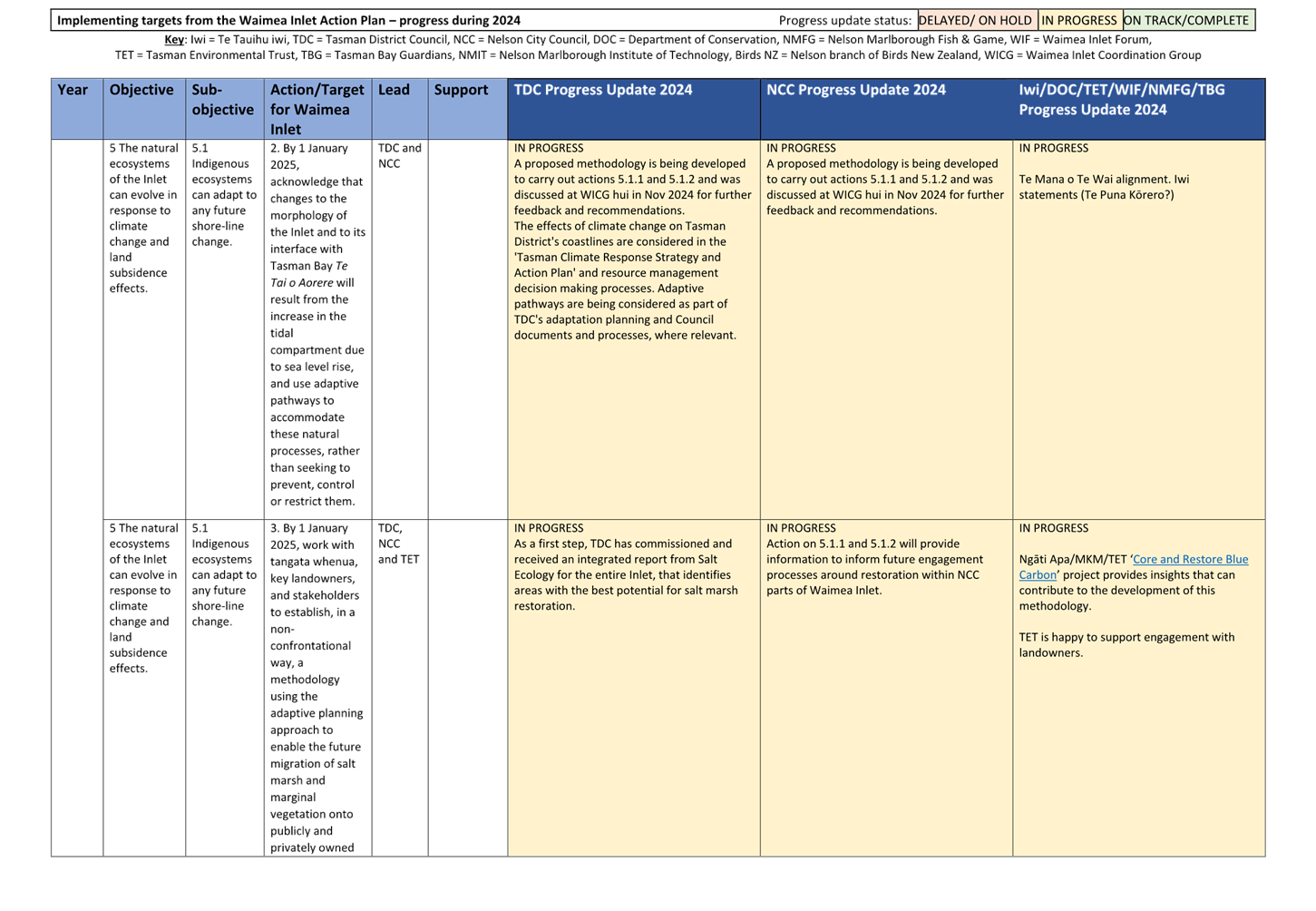
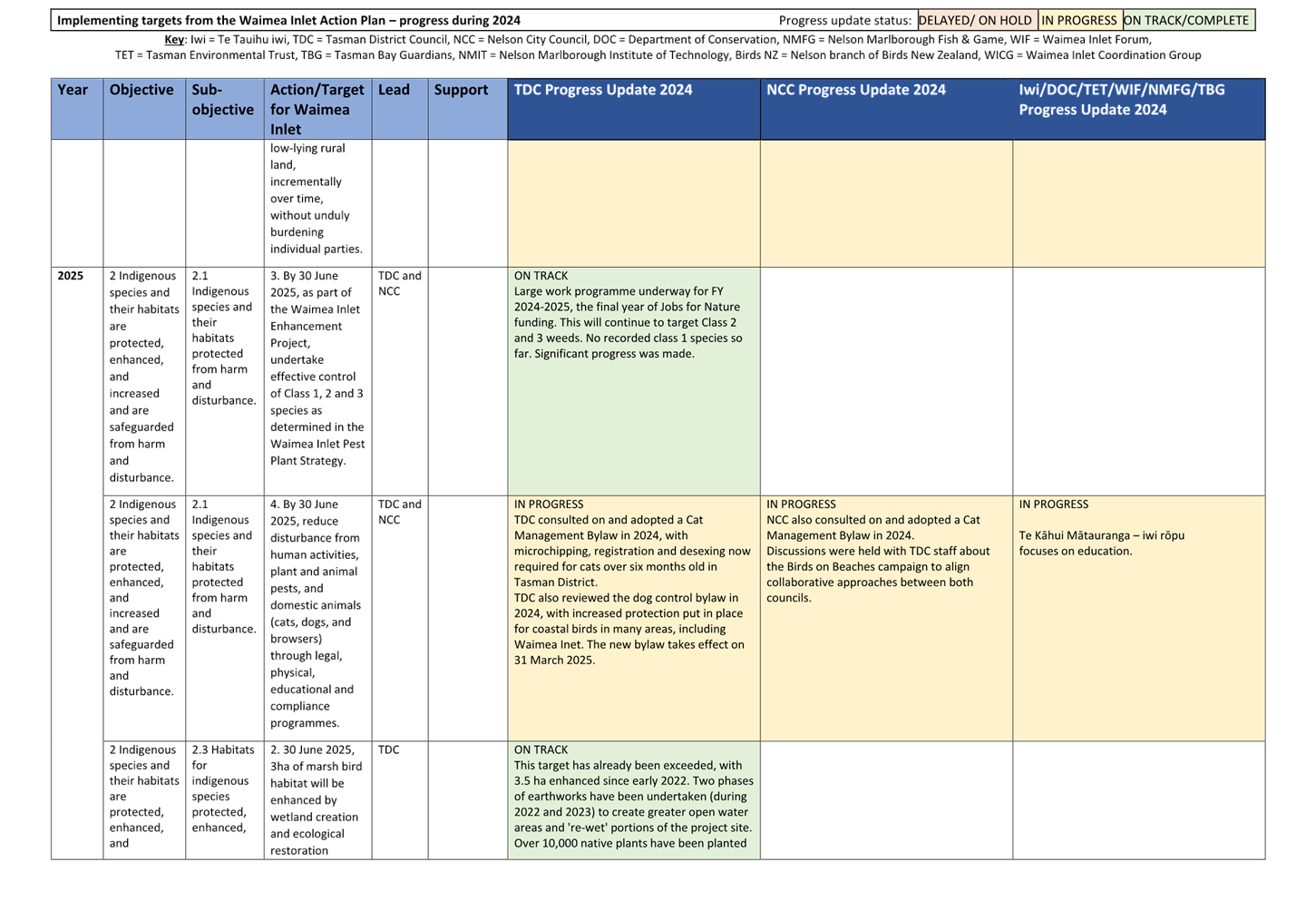
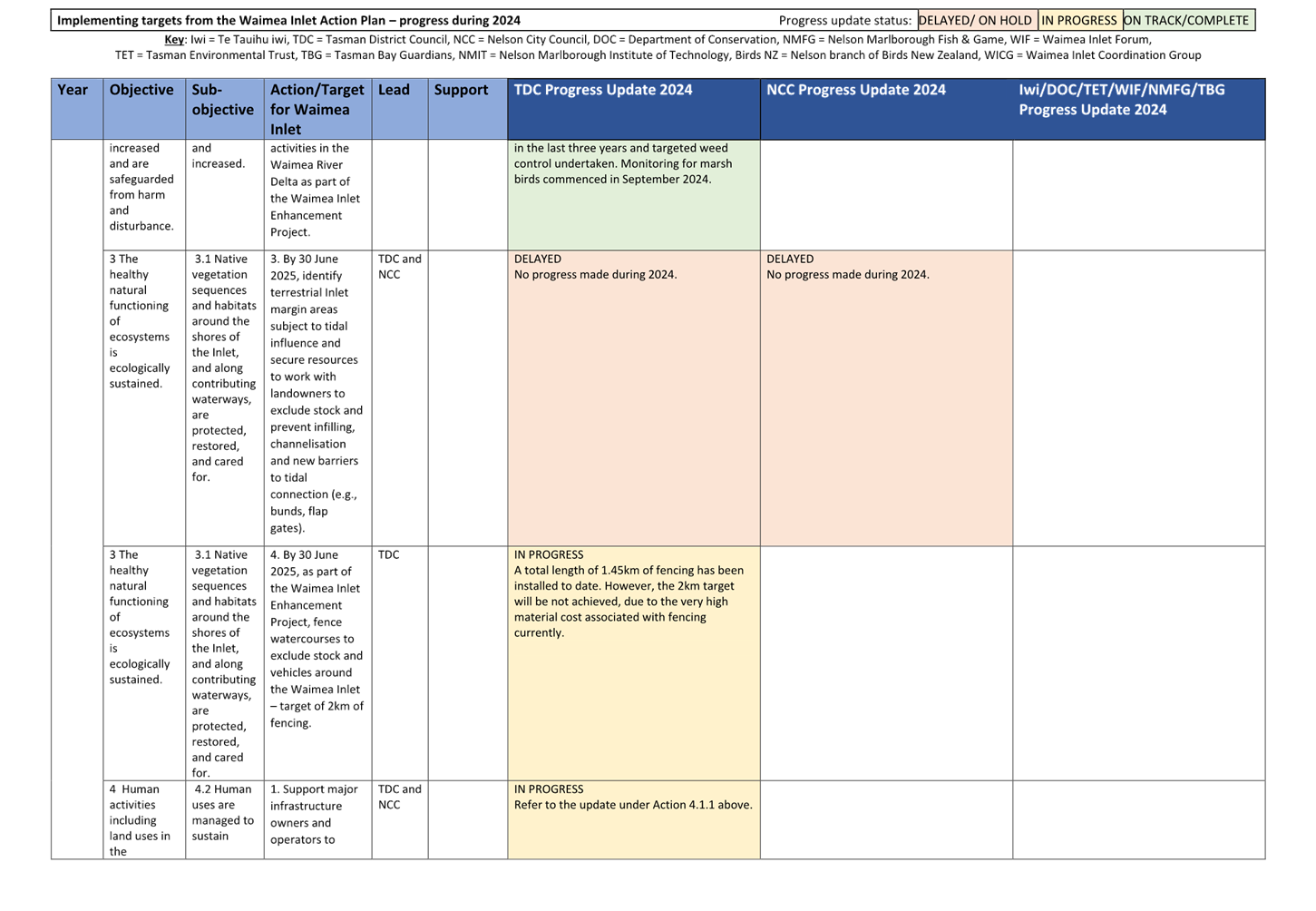
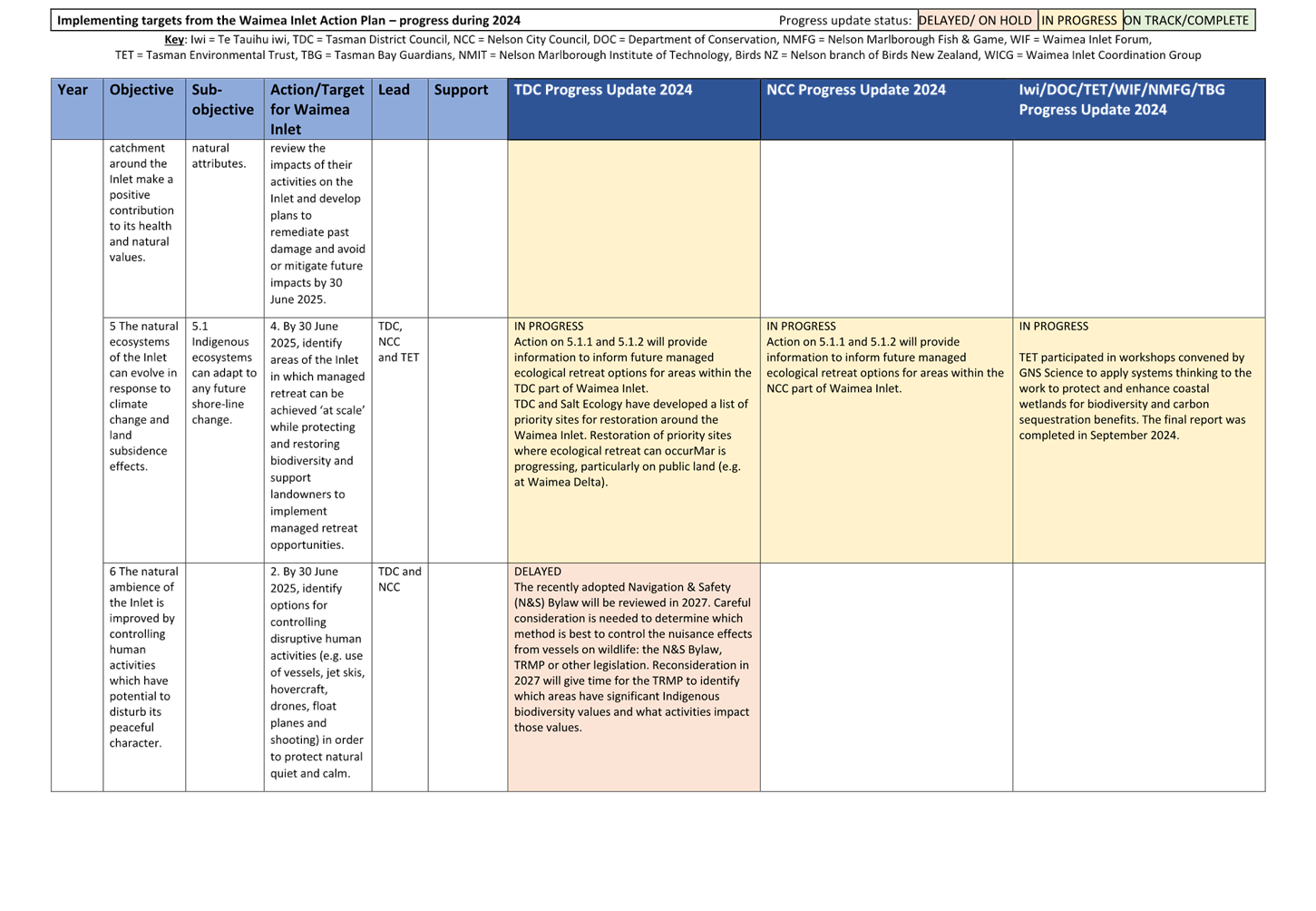
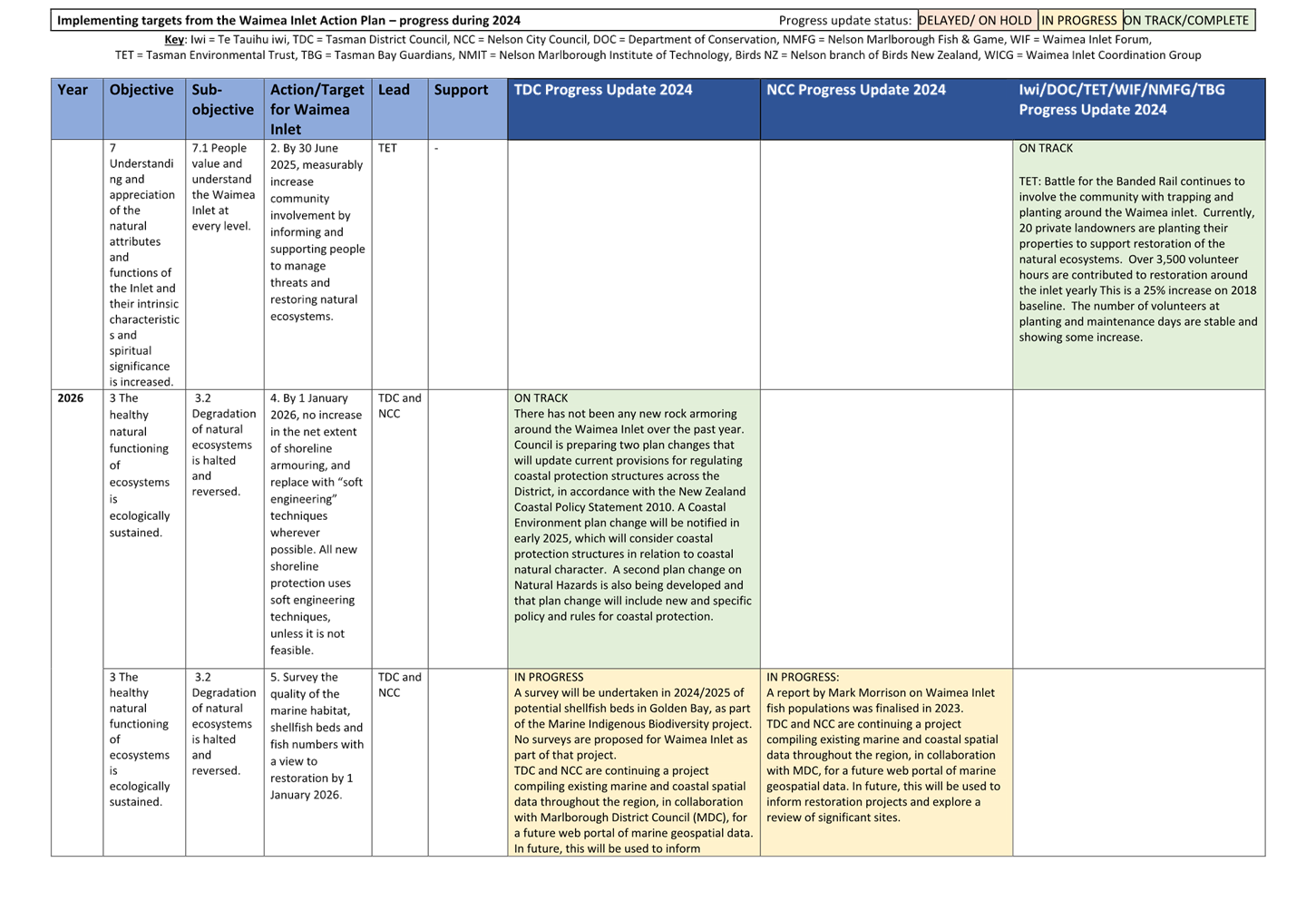
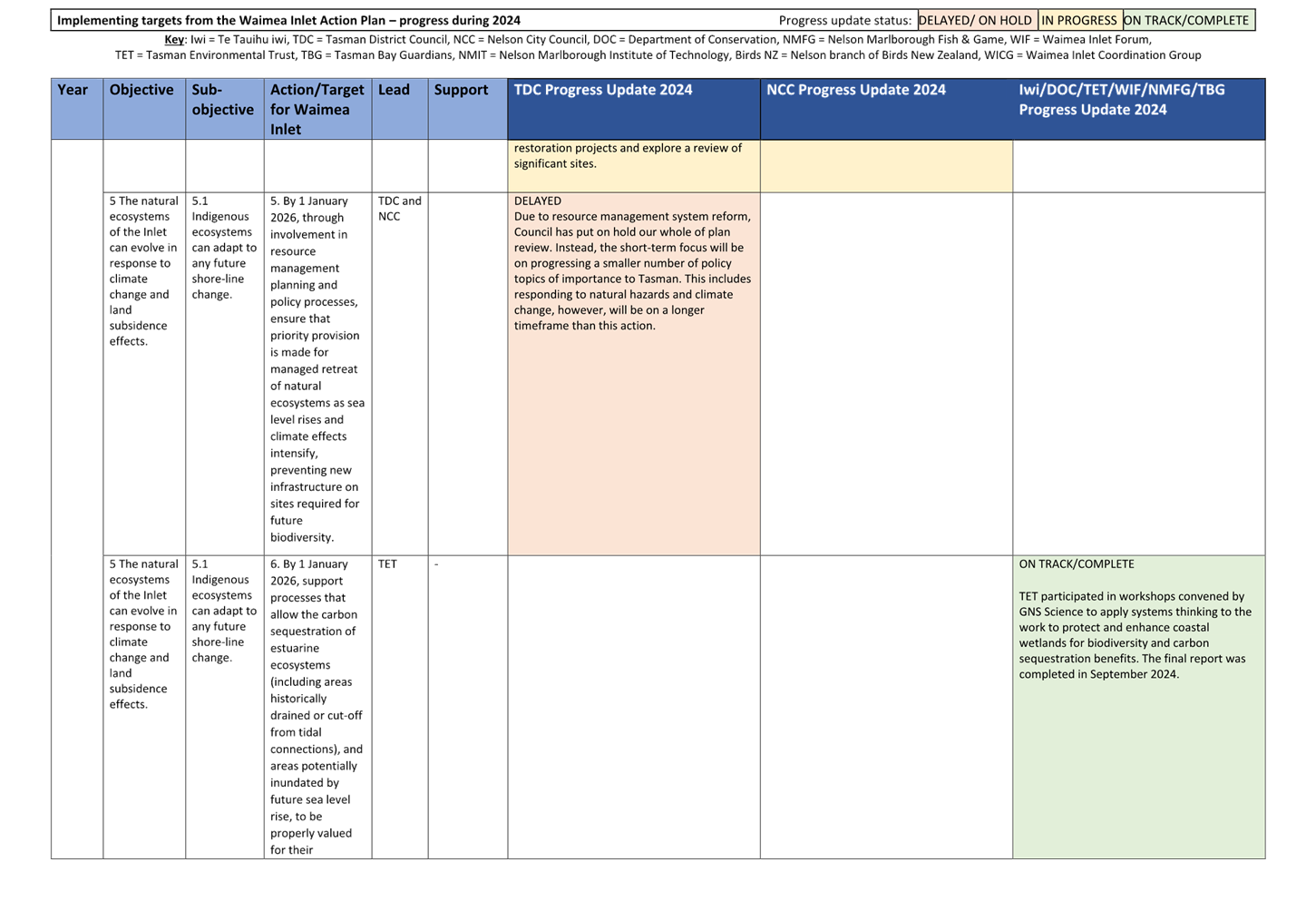
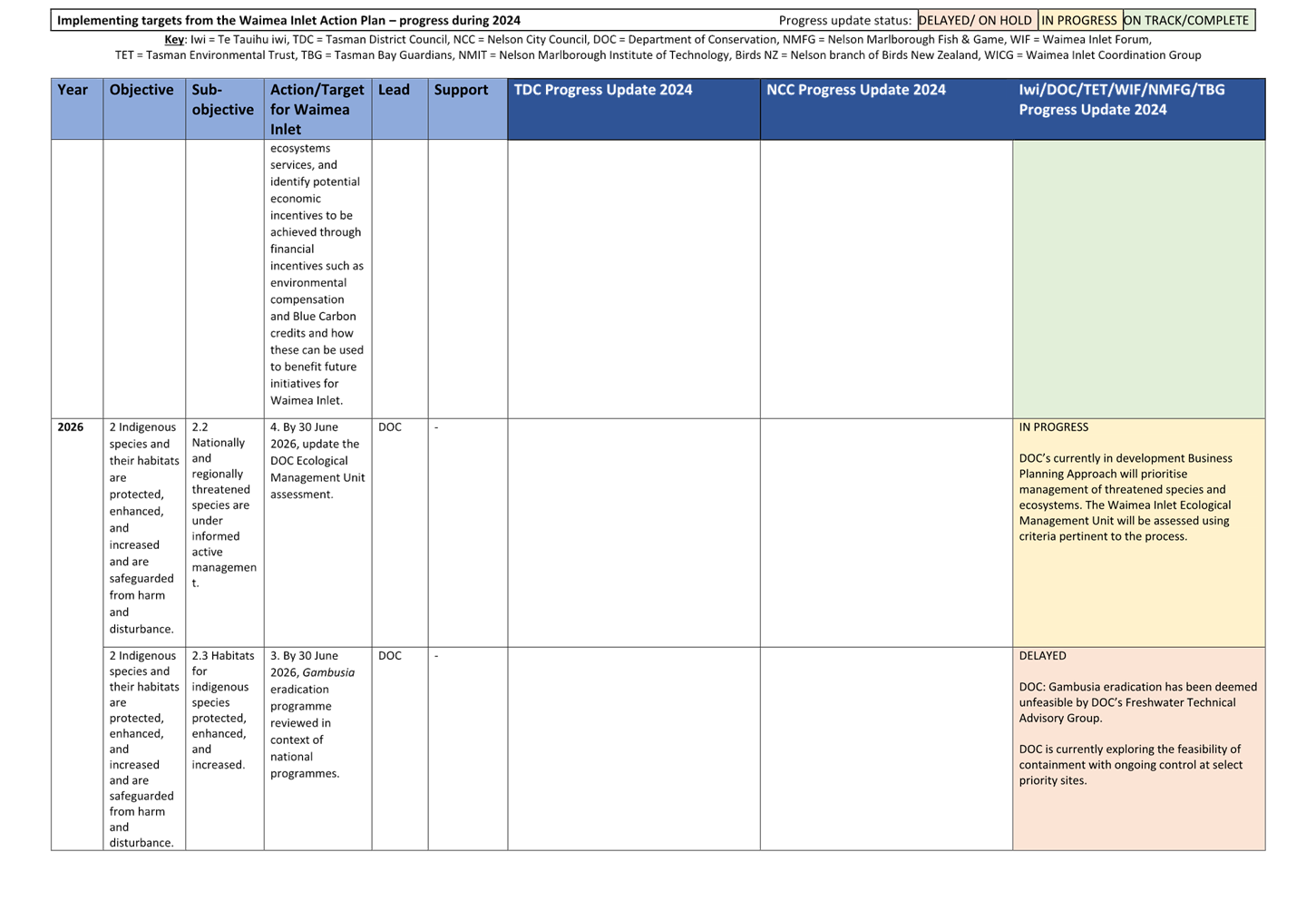
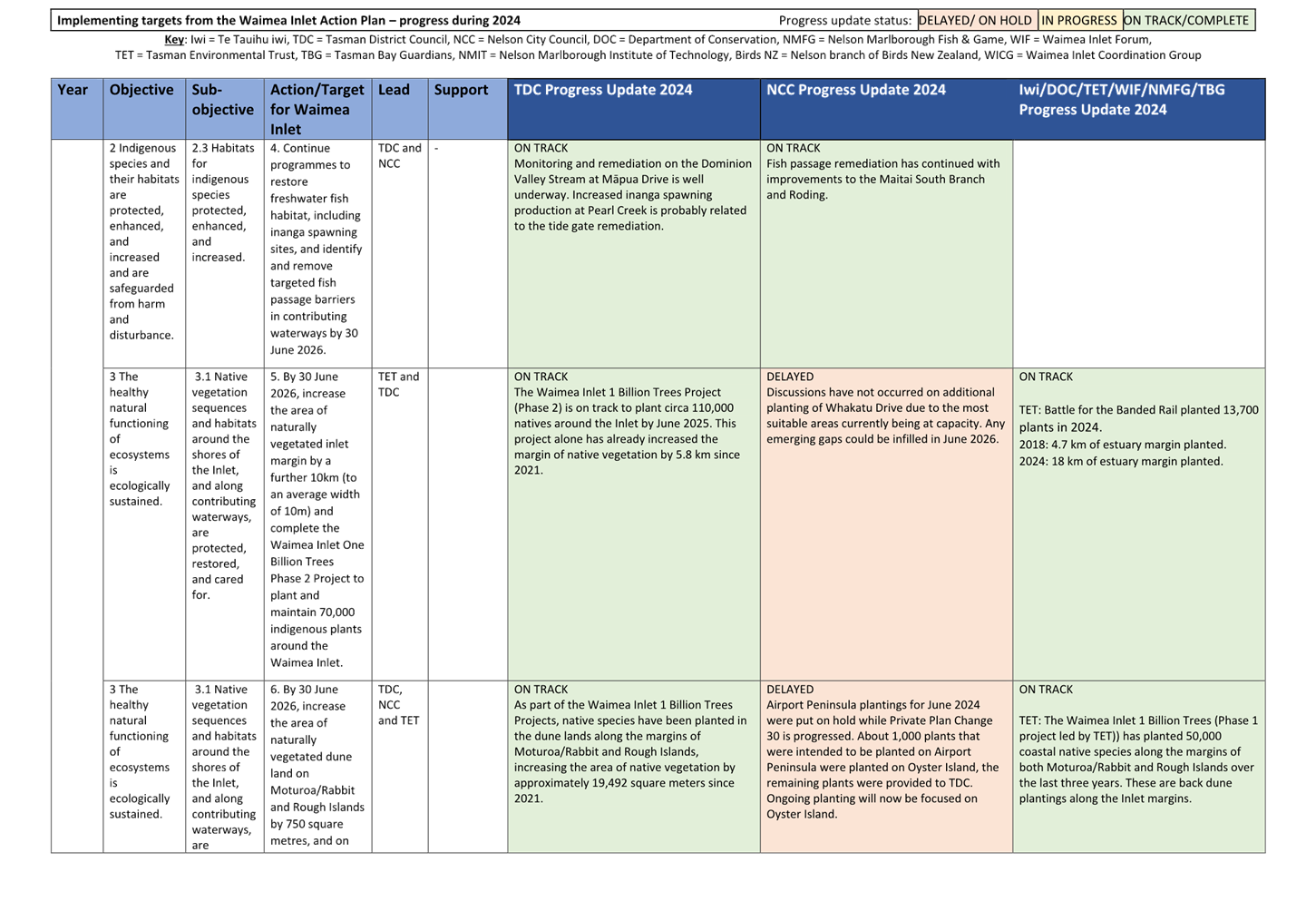
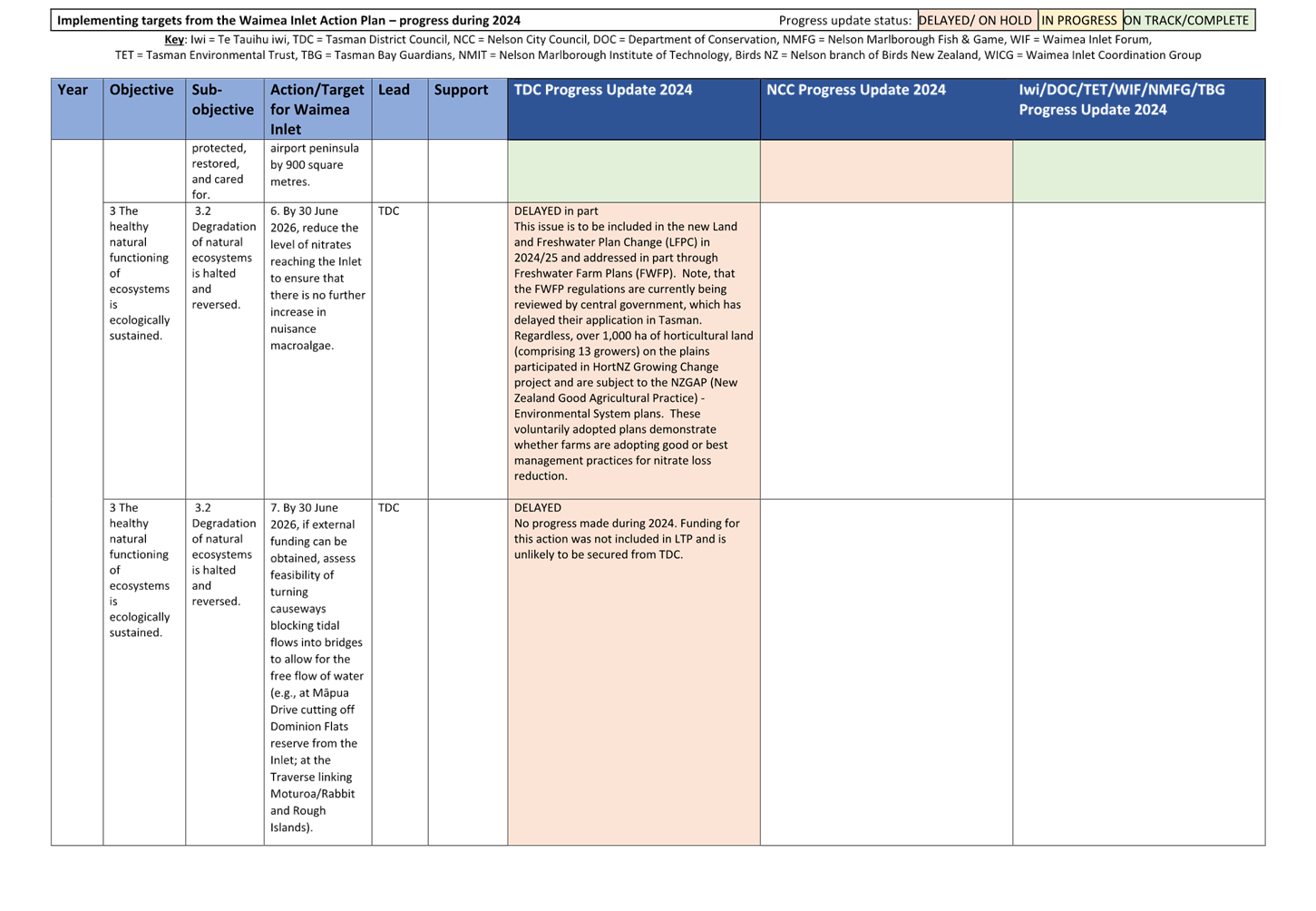
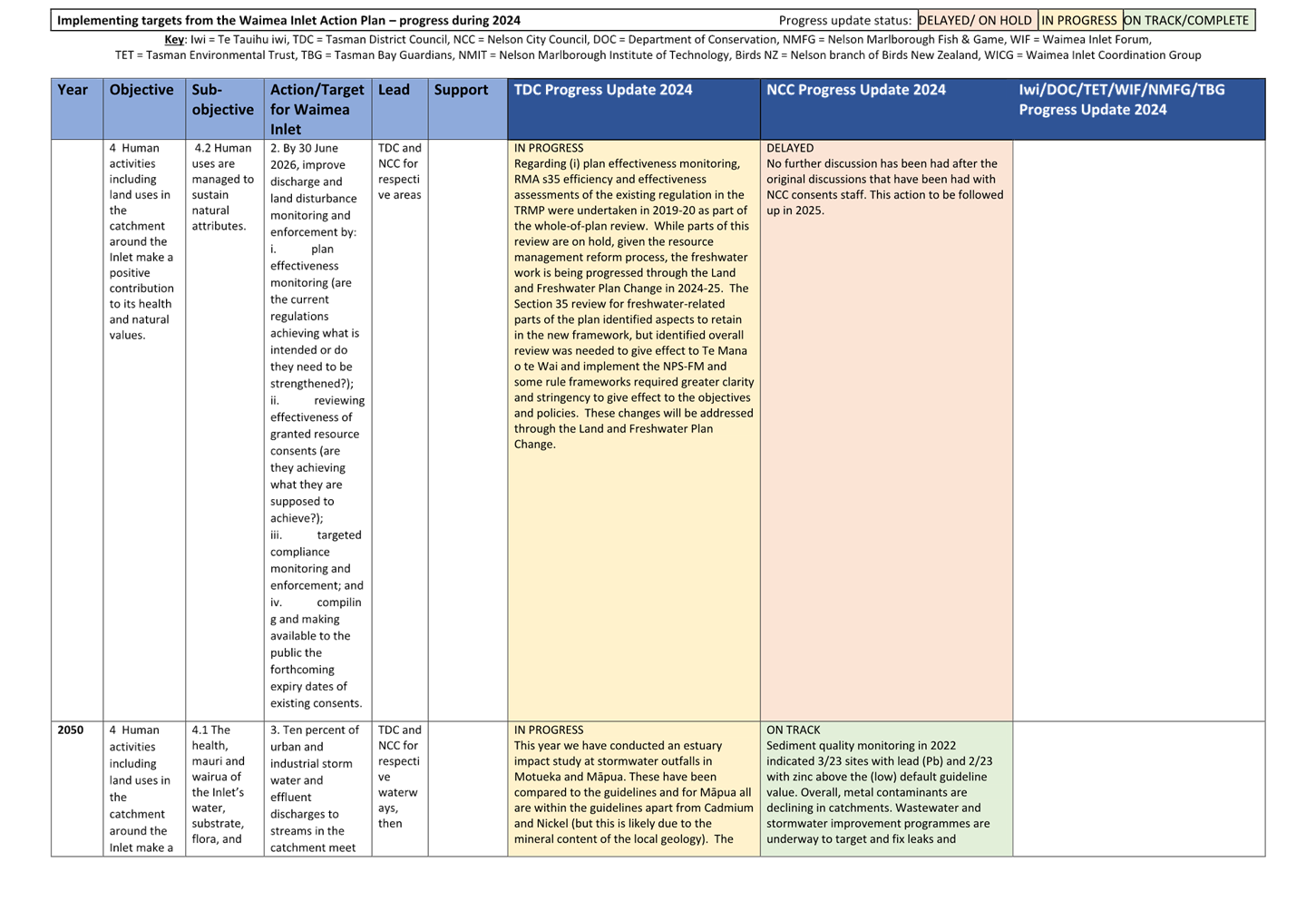
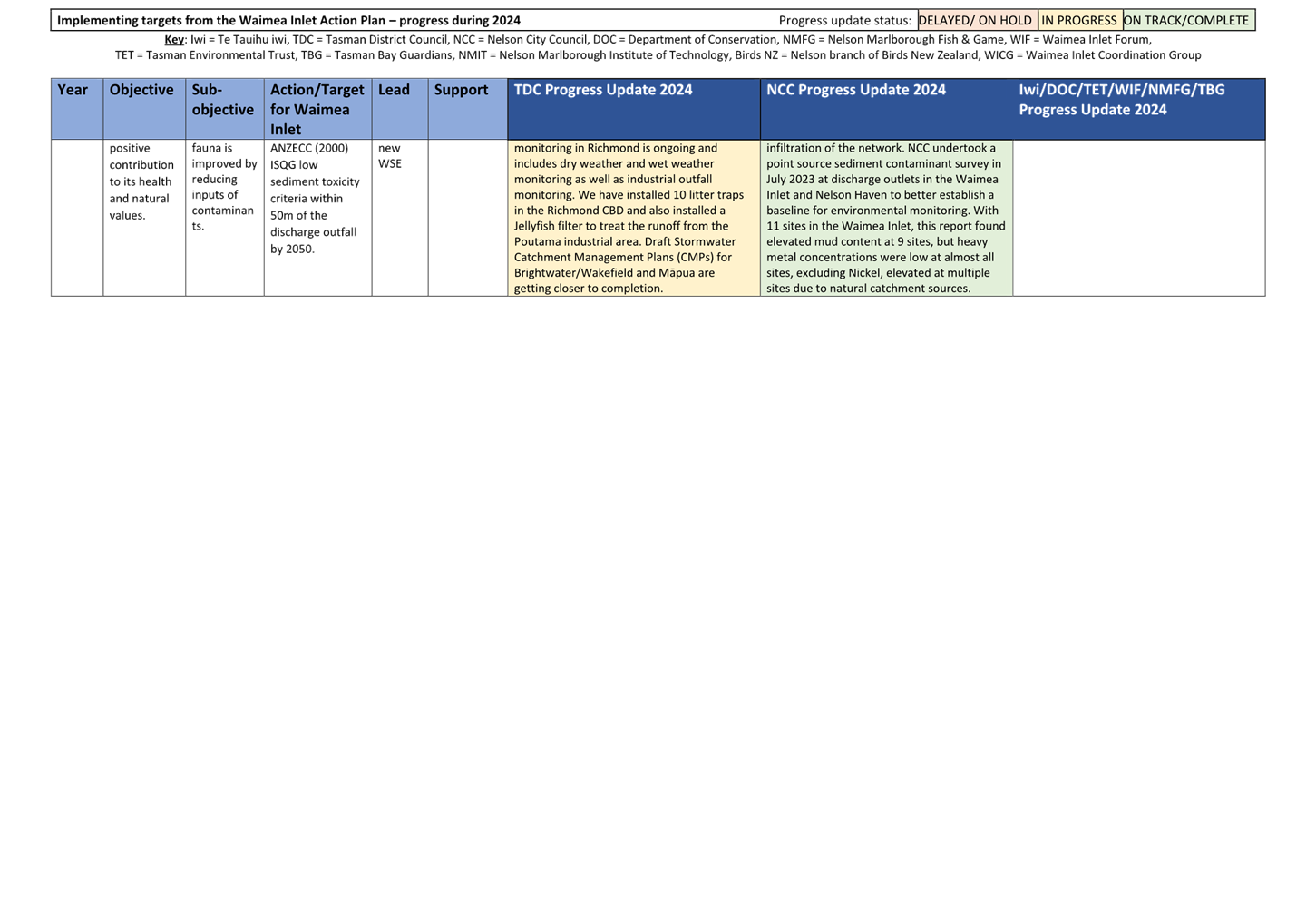
Strategy and Policy Committee Agenda – 19 February 2025
7.5 Strategic Policy and Environmental Policy Activity
Report
Information Only - No Decision
Required
|
Report
To:
|
Strategy
and Policy Committee
|
|
Meeting
Date:
|
19
February 2025
|
|
Report
Author:
|
Barry
Johnson, Environmental Policy Manager; Dwayne Fletcher, Strategic Policy
Manager
|
|
Report
Authorisers:
|
John
Ridd, Group Manager - Service and Strategy
|
|
Report
Number:
|
RSPC25-02-6
|
1. Summary
/ Te Tuhinga Whakarāpoto
1.1 This
report provides the Committee with an update on some of the key highlights of
the Service and Strategy Group’s Strategic Policy and Environmental
Policy work.
2. Recommendation/s
/ Ngā Tūtohunga
That the Strategy and Policy Committee
1. receives the Strategic Policy and Environmental Policy Activity
Report, RSPC25-02-6.
3. Strategic
Policy Update – Dwayne Fletcher
Review of Water Supply Rates
3.1 In
the Long Term Plan 2024-2034 (LTP) consultation document the rating for rural
water schemes was noted as an upcoming issue. We explained that the
increasing costs for these schemes to meet regulatory standards were driving up
current and future rates levels and the likelihood that this would cause some
users to leave the schemes, increasing rates further to those remaining.
We indicated that we would undertake further work on this issue and planned to
consult on options during the 2024/2025 year.
3.2 Staff
have been working to consider options to address this issue and workshops took
place in July and October 2024 to informally seek elected members’
views.
3.3 Since
the LTP was adopted, there has been increased workload for staff involved in
this work, particularly those in the Finance department. We are working
on a particularly difficult Annual Plan for 2025/2026, working through the
financial implications of the Local Water Done Well entity options and plan to
consult on entity options in April 2025, and will potentially introduce a new
rate in the 2025/2026 year.
3.4 Therefore
staff consider that it will not now be possible to have advanced the water
rates review work to the consultation stage in the 2024/2025 year.
3.5 We
consider that this water rates review work should continue to be progressed, so
that the water rates system is in good shape when whatever Local Waters Done
Well entity is formed takes on the management of the three waters.
3.6 Staff
are considering a revised timeline for the water rates review work.
Taking into account the local body election in October 2025 staff advise
that we plan for consultation on the water rates review in March/April
2026. This would still allow the outcomes of the review to be implemented
from 1 July 2026.
Key Projects and Activities
3.7 The following tables contain an
update of the key projects and activities that the Strategic Policy Team either
manages or is involved in.
|
Community Policy
|
|
Project
|
Description
|
Status
|
Comments
|
|
Corporate
Planning
|
|
Annual Plan 2025/2026
|
Preparation of the
Council’s Annual Plan for the 2025/2026 year.
|
On track
|
TCD: 30 June 2025
Direction was provided to
staff at a workshop on 11 December 2024.
Staff are now preparing
material to deliver on this direction and support a series of workshops with
Councillors in late February/early March 2025.
|
|
Development Contributions
Policy Review
|
To review specific
operational aspects of the Policy regarding development contributions.
|
On track
|
TCD: 30 June 2025
A Council workshop is
scheduled for 27 February 2024 to confirm the proposed amendments. Formal consultation
is planned for March/April 2025.
|
|
Schedule of Fees and Charges
2025/2026
|
Annual review of the fees and
charges set by Council – in parallel with the Annual Plan 2025/2026
process.
|
On track
|
TCD: 26 June 2025
The draft schedule has
been circulated to relevant staff for review and preparation. This will be
presented in a Council workshop in late February.
|
|
Review of Water Supply Rates
|
Review the way in which we
rate for water supply in the context of increasing costs impacting the
affordability of some water schemes.
|
On track
|
TCD: To be determined
Workshops were held on 24
July 2024 and on 23 October which considered the range of options, a broad
process and some principles.
Staff have been working on
developing a revised water rating system for elected member consideration. As
noted in paragraphs 3.1-3.6 of this report it is likely that consultation on
a new water rates system will now take place in the first quarter of 2026.
|
|
Reserves and
community facilities
|
|
Classification of existing
reserves in Richmond and Lakes-Murchison Wards
|
Project to classify existing
reserves in Richmond and Lakes-Murchison Wards (this step is required
before Council can publicly notify draft RMPs for both Wards) and one reserve
in Moutere-Waimea Ward
|
On track
|
TCD:
February 2025
Proposals to
classify existing reserves were publicly notified on 14 October 2024.
Submissions closed on 18 November 2024. Hearings and deliberations were held
on 10 December 2024.
A report was
presented to the Council on 13 February 2025, outlining Hearing Panel
recommendations for final reserve classifications.
The final step in the process
is to submit a notice to be published in the NZ Gazette, listing all reserve
classifications.
|
|
Review of Richmond and
Lakes-Murchison Wards reserve management plans (RMP)
|
Project to review the two
existing RMPs.
|
On track
|
TCD:
September-2025
Initial
‘seeking ideas’ feedback round closed 28 March 2024. The revised
timeline and some of the feedback received can be viewed on the maps on the Shape Tasman
project page. Analysis of feedback is complete and development of draft RMP
text is well underway. We are currently engaging with iwi on initial draft
text.
The draft Lakes-Murchison
Ward RMP and draft RMP section on Baigents Bush Scenic Reserve, Pigeon Valley
will be presented to the 3 April Strategy & Policy Committee meeting with
a request that both documents be publicly notified. The draft Richmond Ward
RMP will be presented to the Committee in May 2025, with a request that draft
RMP be publicly notified.
|
|
|
Community Occupancy
Policy
|
Development of a new policy
to guide operational decision-making around entering into and reviewing
leases of Council owned land
|
On track
|
TCD: June 2025
Following the workshop with Councillors in November
2024, the policy and accompanying guidelines are in the final stages of
drafting, with legal review due to commence shortly.
The policy will be
presented to the full Council to consider for consultation at its meeting on
20 March 2025.
|
|
|
Climate
change and environmental
|
|
Tasman Climate Response
Strategy and Action Plan (2023-2035)
|
The Tasman Climate
Response and Resilience Strategy and Action Plan 2024-2035 outlines
investments and actions for climate mitigation and adaptation over the next
10 years.
|
On track
|
Quarterly
Progress Report:
Staff provide regular updates
on progress implementing the Strategy and Action Plan in the ‘Climate
Change Update’ reports to alternate Strategy and Policy Committee
meetings. The next update is due on 3 April 2025.
|
|
Organisational greenhouse gas
inventory
|
Annual monitoring of greenhouse gas
emissions from Council operations
|
On
track
|
Target completion
date: April 2025
Work to prepare the 2023/24
report is underway. The completed report is due to be audited in February
2025.
|
|
Community greenhouse gas
inventory
|
Bi-annual monitoring of
greenhouse gas emissions for the Tasman region
|
On track
|
TCD: April 2026
Staff are providing data to a
consultant, who will provide dashboard information on regional greenhouse gas
emissions.
|
|
Nelson-Tasman Climate Change
Risk Assessment and Explorer (NTCCRA) project
|
The regional assessment
identifies future climate hazards and impacts, informing climate action
priorities and a foundation for adaptation planning for resilience.
|
Delayed
Previous TCD October
2024
|
New TCD: June 2025
The Tasman District Council
and Nelson City Council staff are nearing completion of the regional climate
change risk assessment and geospatial tool.
While delays occurred due to
user-related issues, the project is now for internal review. The project
remains on budget.
|
|
Bylaws
|
|
Public Places
Bylaw
|
Currently no bylaw in force.
Review needed for bylaw to regulate activities, such as hawking, busking, and
food vendors in public places. If needed, make new bylaw.
|
Complete 
|
TCD:
Fourth quarter 2024
The bylaw was adopted at the
Council meeting on 28 November.
|
|
Dog Control Bylaw
|
Cyclic review of Dog Control
Bylaw
|
Complete
|
TCD:
Fourth quarter 2024
The bylaw was adopted at the
Council meeting on 11 December.
|
|
Cat Bylaw
|
Currently no bylaw in
place. If Council supports, make a new bylaw.
|
Complete
|
TCD:
Fourth quarter 2024
The bylaw was adopted at the
Council meeting on 28 November.
|
|
Public Water Supply Bylaw
|
Review to align with changes
to Government legislation and improve current protection levels of safety and
health, environment and Council water infrastructure.
|
Complete
|
TCD: Fourth quarter
2024
The bylaw was adopted at the
Council meeting on 28 November.
|
|
Control of Alcohol in Public
Places Bylaw
|
Cyclic review
|
New
|
TCD: Third Quarter 2025
Early
engagement scheduled for February – early March 2025. Results and a
first draft will be shared with Councillors at a workshop on 10 April 2025.
|
|
Freedom Camping Bylaw
|
Prior bylaw revoked. If
Council supports, make a new bylaw.
|
New
|
TCD: Third Quarter 2025
Staff
supporting the Regulatory Services team. This project will be introduced to
Councillors at the workshop on 10 April 2025.
|
|
Introductory Bylaw
|
Revocation and necessary
minor amendments to other bylaws
|
New
|
TCD: First Quarter 2025
Report to
seek approval for revocation of the bylaw along with other minor amendments
is scheduled for a Council meeting on 13 February 2025. Website updates will
follow.
|
|
Speed Limits Bylaw
|
Revocation
|
New
|
TCD: First Quarter 2025
Report to
seek approval for revocation of the bylaw is scheduled for a Council meeting
on 13 February 2025. This bylaw has been superseded by the Speed Management
Plan.
|
|
Infrastructure Planning and Policy
|
|
Project
|
Description
|
Status
|
Comments
|
|
General
|
|
Motueka
West Development – Joint agreements (IAF) with Kāinga Ora Housing
and Communities and Wakatū Inc.
|
3-Waters
and roading infrastructure to support the first phase of the housing
development by Wakatū in Motueka West
|
Delayed
Previous TCD Oct 2024
|
TCD: April 2025
The
construction of the wastewater and stormwater pipelines are complete.
Wastewater pumpstation is due for tender pending Wakatū confirmation of
location. Manoy Street roundabout is on hold pending consent approval. The
Wakatū resource consent application is on hold pending review of the
traffic impact on Whakarewa/High Street intersection and confirmation of
non-vesting of roadways. Memo to ELT meeting 5 November confirmed
preferred position on road funding gap. Plan Change 80 hearing held on Friday
8 November.
|
|
|
Local Water Done Well
|
Supporting development of the Water
Services Delivery Plan, led by Community Infrastructure
|
On track
|
TCD June 2025
Drafting of Indicative Business Case
underway. Work on Water Services delivery plan starting. Submissions made on
new levies. Submission due to be submitted on Bill 3. Consultation required
being worked through
|
|
|
TRMP Changes
|
Roading and three waters report to
address servicing for the identified components of PC81 and PC80.
|
On track
|
TCD:
Hearing for PC 80 - Q4 2024
Hearing
for PC 81 – Q1 2026
Initial report completed. Revised report required on
the status of infrastructure to service PC81 & PC80. May require further
investigations on options to service the proposed zoning changes
|
|
|
FDS Implementation – change
management framework to support infrastructure planning
|
To support the implementation of
FDS by way of having a change management process and infrastructure planning
framework (in conjunction with the PMO)
|
On track
|
TCD
Ongoing programme of work
Working on
basis of information and ways of holding this information for all to use.
Initial scoping and way forward completed December 2024. Request for GIS
resource underway, and scoping of GIS work also underway.
Initiative started on capturing capacity of key
infrastructure to represent programme of works and any gaps in information.
|
|
|
Transport
|
|
Joint
Speed Management Plan
|
Undertake a review of speeds across Nelson and Tasman,
culminating in a Joint Speed Management Plan to submit to Waka Kotahi. The
new speed limits can be introduced over time once approved.
|
On track
|
TCD:
Approval of first tranche of changes - Q1 2025
Approval of second tranche of changes – Q3 2025
Reconsulting on high-risk roads, roads around rural schools and
McShanes. Consultation closes on 2 March. For all other SMP roads,
consultation is planned for April onwards
|
|
|
Transportation
Policies and Procedures Manual
|
Update of the transportation policies and procedures manual
|
On track
|
TCD: December 2025
Work is continuing with this review. A workshop is scheduled in
March 2025.
|
|
|
EBus
Review
|
EBus services are reviewed after one year. Phase one: provide
data to NZTA
Phase two: review future improvements
|
On track
|
TCD:
March 2025
Phase
one is complete with data being sent to NZTA and confirmation of ongoing
funding for existing services provided.
Phase
two: Workshop to Regional Transport Committee on 10 March.
|
|
Stormwater
& Rivers
|
|
Richmond
South Stormwater Programme
|
Development of a stormwater management programme for
existing and future development areas in Richmond South, including
cross-section designs for planned drain upgrades.
Stormwater
Management Plan will feed into a future structure plan for the area scheduled
to commence later this year.
|
On track
|
TCD: Ongoing programme of work
The
next report for the Strategy and Policy Committee is to confirm the design of
the channel for works uphill of SH6. This report has been delayed by
engineering technical issues. These include the need to consider the impact
of development proposals beyond the current residential zoned land and the
latest stormwater model outputs.
Several
property purchases are in progress.
The Stormwater Structure Plan consultant has been engaged.
|
|
|
Māpua, Ruby Bay, and Coastal Tasman Catchment
Management Plan (CMP)
Now
incorporated into the Māpua Master Plan
|
A
stormwater model for Māpua, Ruby Bay, and Coastal Tasman to identify
locations that are at risk of stormwater flooding in 1% and 10% AEP events
was prepared in 2022, with the intention of completing the Catchment
Management Plan as required under the Council’s stormwater discharge
consent.
|
On track
|
TCD: Q2 2025
The draft CMP is included as an annex to the draft Masterplan. Following consultation, a final plan will be proposed.
|
|
|
Brightwater
and Wakefield Catchment Management Plan
|
Development
of a stormwater catchment management plan for the Brightwater and Wakefield
Urban Drainage Areas, as required by Tasman District Council’s
stormwater discharge consent.
|
On track
|
TCD: Q2 2025
The
remaining issue delaying the draft CMP is completion of a Cultural Impact
Assessment.
|
|
|
Richmond
Central Stormwater Business Case
|
Business
case to assess the management of stormwater in the Richmond CBD
catchment
|
On track
|
TCD: Q4 2025
The various options for cost-effective reductions in flood hazard to central
Richmond are still being considered but are now in line for further modelling
in 2025 behind the Richmond South investigations as noted above.
Integration with design for FDS growth areas under PC81/Richmond
on the Rise is proposed to maximise return on investment.
|
|
|
District-wide
Stormwater Flood Modelling
|
Stormwater
modelling covering the entire District at a high level to inform future CMP
for smaller Urban Drainage Area, and to assist with rural stormwater
management.
|
On track
|
TCD: Q4 2025
This modelling sits in the programme behind Richmond south and
Richmond central. The most cost-effective method will vary across the
District considering if an existing river model (eg Takaka), or partial urban
model (eg Murchison, Pohara) or nothing exists (eg Patons Rock). Potential
for the programme to be delayed by cost-cutting drivers.
|
|
|
Water and
Wastewater
|
|
Wastewater
modelling
|
Modelling of Waimea Wastewater network
Network
monitoring, data analysis and model outputs will inform the timing of
specific capital works projects that are planned as part of the Waimea
Wastewater Network Strategy.
|
Complete 
|
New TCD: Q1 2025
Staff
have engaged consultants to undertake a four-staged modelling project for the
Waimea wastewater trunk main. Consultants recommended the collection of
additional flow data before building and calibrating the model. This has been
done and calibration of the model is complete. The TCD has been
previously extended due to a lack of storm events and associated flows to
help staff test any model against.
|
|
|
Te Tai o Aorere Draft Regional Wastewater
Philosophy
|
An
initiative between the Council, NRSBU and potentially iwi to develop
50-to-100-year vision for iwi and community aspirations for future wastewater
networks. The plan will identify values, objectives, and
outcomes. In the absence of the three waters direction, this work has
now evolved into a component of the Motueka wastewater solutions project.
This work will form the basis of understanding for a relationship between iwi
and Council, initially to support the Motueka and Tākakā wastewater
treatment plant projects for the Council.
|
Complete

|
The
developed outcomes and objectives of the RWWP will continue to support and
inform the Motueka and other wastewater treatment solutions projects as they
progress. This is the outcome of initial discussion between the
Council’s CEO and iwi CE’s.
|
|
|
Motueka
Wastewater Solutions Project (to replace the current Motueka WWTP)
In support of Programme Delivery
|
The
Motueka Wastewater Reference Group has been restarted. The Motueka WW
solutions project has started and the first-year pre-project planning and
investigation phase for has commenced. (Alternative solution for the current
site of the WWTP prior to the current consent expiry in 2035.)
|
On track
|
Phase 1
of the 10yr Motueka WWTP solution project has commenced 1 July 2024 -
Year 1
- Preplanning
Goal 1 -
Reactivation of the Motueka WW Reference group (action completed)
commenced with a hui on 10 July 2024. The reference group is now
actively moving forward with regular hui with relevant Council staff. First
tasks for the group will be developing criteria to remove rahui (involves ESR
and shellfish testing. External funding sources are being explored with the
integrated catchment team) and developing cultural monitoring skills to
ensure current consent conditions for WWTP discharge can be met. Estimated
completion end of year 2025.
Goal 2 -
completion of the Tasman relationship agreement Council, ELT and iwi CE -
Jan/Feb 2025. An alternative process has been proposed in the initial CE
discussions that will uphold the five principles of the ‘Together Te
Tau Ihu Partnership’ alongside using the outcomes and objectives of the
RWWP work to inform the wastewater project going forward. Iwi representation
for wastewater was agreed and is still work in progress to be confirmed by
all CE’s.
Goal 3 -
lessons learned WCD December 2024. Work is with the CEO and Mayor in draft
format for comments. Draft completed.
Goal 4 -
Project Board (iwi inclusive) and sponsor set up before end of March.
Goal
5 - Cambridge WWTP process/site visit before June 2025.
|
|
|
Inflow
and infiltration management plan
|
Drafting
plan to help reduce inflow and infiltration into wastewater network within
available budget
|
On track
|
TCD:
July 2025
Currently
in early initiation phase, working with operations staff to form the basis
for the overall plan. Final plan will go to the Infrastructure Group Manager
for approval.
|
|
|
Waimea
trunk water and wastewater
|
Working
with Project Delivery to draft working brief in conjunction with hydraulic
modelling work
|
On track
|
TCD:
Phase 1 Feasibility July 2025
Work has
commenced to define the first phase of the new water and wastewater trunk
main network linking Wakefield, Brightwater and Richmond.
Construction of water and wastewater mains between
Wakefield and Brightwater will be combined into a joint contract.
|
|
|
Wai-iti
Dam augmentation design and consent application
|
Writing
a resource consent application for the water intake and pipeline
|
Delayed
|
TCD: Initial application by March
2025
Awaiting
final pieces of information to complete and landowner agreements. 95%
complete.
Updates to
TCD will be made once consent is submitted.
|
|
Waste
Management and Minimisation
|
|
Joint Waste Minimisation and Management Plan (Waste Plan)
|
Review the Nelson Tasman Waste Minimisation and Management Plan
(Waste Plan), as required under the Waste Minimisation Act 2008.
|
On track
|
TCD: July 2025
Working
Party meetings were held in April, June, September and October 2024. At the
29 October meeting, the Working Party considered the final draft of the plan
and have recommended it for consultation.
The draft
plan for consultation was considered by Council on 11 December and
Nelson City Council on 5 December.
Public
consultation will run from 1 February to 7 March 2025. We expect that the
final plan will be adopted in July 2025.
|
|
|
Coastal
|
|
Update
of Coastal Protection Policy
|
Update
of Overarching Coastal Protection Policy with linkages to Proposed Reserves
and Roads (other land) policies
|
On track
|
TCD: Q4
2025
A
new policy has been drafted for inclusion in the Transportation Procedures
and Policy Manual update currently in preparation and due for completion in
Q4 2025.
|
|
|
|
|
|
|
|
|
4. Environmental Policy Update – Barry
Johnson
4.1 The
Environmental Policy team is currently managing nine significant projects (plus
a host of smaller ones) that will all result in changes to the current Tasman
Regional Policy Statement, the Tasman Resource Management Plan (TRMP) or form
part of the replacement plan (Tasman Environment Plan) when that is
restarted. The projects include eight plan changes at various stages and
a new Master Plan project:
4.1.1 PC 76 Wakefield
4.1.2 PC 79 Deferred Zoning
4.1.3 PC 80 Motueka West
4.1.4 PC 81 Urban Growth
4.1.5 PC 82 Outstanding Natural Landscapes and Features
4.1.6 PC 83 Coastal Environment and Natural Character
4.1.7 PC 84 Land and Freshwater
4.1.8 PC 85 Natural Hazards
4.1.9 Motueka Master Plan.
4.2 The
plan changes and a number of other areas of work are covered off in the
sections below under the workstream headings.
Urban Growth
Future Development Strategy
4.3 The
Future Development Strategy (FDS) Implementation Plan 2024 was adopted
alongside the FDS monitoring report 2024 by the Joint Nelson Tasman Committee
on 19 November 2024. The adopted implementation plan replaces the version
adopted in 2023. The National Policy Statement for Urban Development (NPS UD)
requires the Council to update the FDS implementation plan annually.
4.4 The implementation plan outlines
how the FDS will be implemented, by whom and timeframes for the actions
identified in the plan. Actions have been informed by meetings held with
Council staff and external key stakeholders, including:
· Ministry of Education
· Ministry of Housing and Urban Development
· Kāinga Ora – Homes and Communities
· Health New Zealand Te Whatu Ora – Nelson Marlborough
· Nelson Bays Primary Health
· New Zealand Transport Agency Waka Kotahi
· Transpower New Zealand
· Network Tasman Limited
· Nelson Electricity Limited
· Nelson Regional Development Agency
· Nelson Regional Sewerage Business Unit.
4.5 The
implementation plan also provides the latest indicative staging of the FDS
sites, detailing which sites are likely to be rezoned and serviced in the
medium term (2024 to 2034) or long term (2035 to 2054). A key component of the
plan is the zoning of enough land to provide for the next 10 years of urban
growth in Tasman through Plan Change 81.
Plan Change 76 Wakefield
4.6 The
purpose of PC76 is to provide additional land for residential housing and
encourage both intensification and a variety of densities within a parcel of
greenfield land in Wakefield.
4.7 The
decision on PC76 was publicly notified on 9 September. One appeal was lodged
with the Environment Court. Initial attempts to resolve the appeal were not
successful so Counsel for Tasman District Council has indicated to the court it
wishes to enter formal mediation with the appellant to resolve the appeal
points without the need for a court hearing.
4.8 The
court is yet to set a date for mediation and staff will keep the Council
informed of any developments.
Plan
Change 79 Deferred Zones
4.9 The
purpose of PC79 is to provide a robust method to enable deferred land to be
released for development when required. It will also rezone some deferred
land for development that previously was identified for housing and business
uses.
4.10 PC79
was publicly notified on 1 November 2024 following consultation with
landowners, affected neighbours and statutory stakeholders on the draft plan
change.
4.11 The
submission period closed on 13 December and 23 submissions have been received.
The call for further submissions alongside a summary of submissions was
notified on 4 February and closed on 18 February.
4.12 The
next steps are for staff to work through submissions to determine whether any
submission points can be resolved informally and to start preparing for a
hearing. The hearing date has been tentatively set down for 23 and 24 June.
Plan Change 80 Motueka West
4.13 The
purpose and objective of PC80 is to rezone land in Motueka West from Rural 1
deferred Residential to Residential – Compact Density, and to enable
medium-density housing. The FDS forecast that population growth in
Motueka cannot be met without releasing additional land for urban
development. This proposed plan change addresses that need with smaller
lot sizes and smaller dwellings within the plan change area.
4.14 PC80
was publicly notified on 15 December 2023. Submissions and cross submissions
closed on 19 April 2024. Submissions raised a number of issues that required
commissioning further analysis and information. A hearing for PC80
was held on 8 November 2024. The hearing panel members were Gary Rae
– independent commissioner as chair alongside Councillors Maling and
Maru. The adoption of the hearing panel’s report and
recommendations are subject to a separate paper to this Committee.
Plan Change 81 Urban Growth
4.15 PC81
is a significant project to rezone enough land to provide for the next 10 years
of urban growth in Tasman and implements the first 10 years of growth as set
out in the FDS. It involves changes to the Tasman Regional Policy Statement
(TRPS) and TRMP. There are a number of aspects to the plan change set out
below.
Changes to the Regional Policy
Statement
4.16 Changes
to the TRPS to give high level direction towards prioritising a suitable supply
and variety of homes in the right locations, and to provide for sufficient
business opportunities.
Greenfield rezoning
4.17 The
FDS assumes that 44% of future growth will be accommodated through greenfield
expansion. The intention is to rezone the greenfield FDS sites that are needed
within the next 10 years. These zones include:
4.17.1 Medium Density Residential Zone -
Greenfield locations where higher density is appropriate (e.g. Wakefield sites,
Motueka site);
4.17.2 Residential Zone - Greenfield locations
where standard density is appropriate (Takaka, Tapawera, Brightwater);
4.17.3 Rural Residential Zone - Unserviced rural
areas (St Arnaud, Rangihaeata, Brightwater, Richmond); and
4.17.4 Light Industrial Zone and Mixed Business
Zone (Takaka, Richmond).
Introducing a new Medium Density
Residential Zone
4.18 This
will create a new zone in the TRMP that enables and requires medium density
housing. This will be developed to support intensification of Richmond,
Brightwater and Wakefield.
4.19 The
new zone will also enable higher density development in greenfield areas such
as Motueka and Wakefield.
Other zone changes
4.20 Changes
to commercial zones in Richmond and Murchison.
Workers’ accommodation
4.21 Update
the rules for workers’ accommodation to make them more flexible and more
permissive.
Urban centres’ hierarchy
4.22 Provide
a hierarchy of Richmond centres that are consistent with Nelson and allow our
town planning decision making to be more effective.
Progress and next steps
4.23 Discussions
with affected landowners have occurred. This was followed by an information
campaign with the wider community over November/December 2024. The sites being
recommended for rezoning were identified through the FDS so landowners were
already aware their land is earmarked for development. Feedback from this
process was generally supportive.
4.24 The
draft plan change is currently being finalised and this will be workshopped
with Council ahead of its public release and call for feedback in late
March. Current plans are for public notification later in 2025.
PC 82 & 83 Outstanding Natural
Landscapes and Features, and Coastal Environments and Natural Character
4.25 A plan change to identify
Tasman’s Outstanding Natural Landscapes and Features, alongside a second
plan change that will redefine Tasman’s Coastal Environment line and
identify areas of coastal natural character, are progressing. The plan changes
are at the point where the plan provisions have been
drafted and staff are now seeking feedback from Department of Conservation
(DOC) on the draft provisions. Staff have contacted DOC and are in the process
of arranging a meeting, however recent staff changes at DOC are causing a delay
while an appropriate replacement staff member is found.
4.26 Staff
are also continuing to work with iwi to gain the necessary input to complete
the plan changes.
4.27 The
next steps for the plan changes once work with DOC and iwi is completed will be
to workshop the draft plan changes with the Council. Following that, the
draft plan change will be made public so affected landowners, and any
interested people can provide informal feedback. This will be followed by
a decision on public notification later in 2025.
Plan Change 84 Land and Freshwater Plan Change
4.28 PC84
involves changes to the TRPS and TRMP to address land and freshwater issues in
Tasman under the National Policy Statement for Freshwater Management 2020
(NPS-FM), including to assist in achieving the purposes of Te Waikoropupū
Water Conservation Order.
4.29 The
Strategy and Policy Committee received a report at its 28 May 2024 meeting that
provided a comprehensive update on this plan change. In summary the key
freshwater workstreams relating to the plan change that were progressed through
2024 include:
4.29.1 Draft Land and Freshwater Plan Change (LFPC) development;
4.29.2 Te Puna Kōrero ki Te Tauihu (TPK)
collaborative group (councils and iwi);
4.29.3 science advice and supporting information
development;
4.29.4 review of protections for the Outstanding
Values of Te Waikoropupū and aquifer listed in the water conservation
order;
4.29.5 Waimea Plains Nitrate Project (in
conjunction with Horticulture NZ and growers);
4.29.6 iwi and stakeholder engagement on draft
plan approach options; and
4.29.7 scoping public engagement process on the
draft LFPC.
4.30 Of
note is the completion of the work of Te Puna Kōrero ki Te Tauihu (TPK)
collaborative group. This working group of eight Te Tauihu iwi, Ngati Wae Wae,
and the three councils has worked to identify the key issues and outcomes for
freshwater for iwi. It has been a successful collaboration, and the next
steps are for Tasman to work with iwi on Tasman specific issues to inform the
LFPC.
4.31 A
big challenge to this project is ongoing uncertainty from Wellington regarding
the content and timing of changes to the NPS-FM that the Government has
signalled. Changes to the Resource Management Act (RMA) late last year have
effectively prevented councils from notifying a freshwater plan change until
the current NPS-FM has been replaced. Government has
committed to replacing the current National Policy Statement for Freshwater
Management (NPS) by 2026. However, timing of the release of consultation
material on the NPS-FM changes appears to be slipping. In mid-2024
ministers indicated the proposed changes would be released in late 2024. This
date was then revised to early 2025 and more recently indications are that the
release could be pushed out further and even possibly bundled into the RMA
replacement package. The Prime Minister in his recent state of the nation
speech said that he expected to introduce legislation to replace the RMA
“this year”. This represents a change from previous statements from
ministers that legislation would be introduced mid-2025 and passed into law by
the end of 2025. Furthermore, the recently released Coalition
Government’s Q1 Action Plan for New Zealand includes the following
related actions:
· “Take
Cabinet decisions on the major legislative architecture for the
Government’s replacement legislation for the Resource Management Act
“
· “Take
Cabinet decisions on new national direction for freshwater and pragmatic rules
for on-farm water storage and vegetable growing.”
· “Take
Cabinet decisions on system design for improved and simplified Freshwater Farm
Plans.”
4.32 This
introduces a lot of uncertainty for the whole of the environmental policy work
programme.
Natural Hazards
4.33 In
May 2024 the Council agreed to the scope and proposed work programme for the
Natural Hazards Plan Change (NHPC). A workshop with
Council was held on 8 October 2024 where the high-level issues and options for
the NHPC were discussed.
4.34 The
Natural Hazards Awareness Campaign launched on 10 February 2025 with severe
weather being the focus for the week. Wildfire, coastal hazards, flooding and
geological hazards will occur in the following weeks through to 17 March 2025.
The aim of the campaign is to inform and raise the community’s awareness
of the natural hazards in the District and introduce complex information in an
easily understandable manner, prior to engaging with the community on the
issues and options. The natural hazards pages on the Council’s website
have been revised and updated to support the awareness campaign. A natural
hazards map viewer, due to go live late February 2025, will the display the
location and extent of natural hazards that can occur across the District where
technical information or modelling is available.
4.35 Staff
are preparing for community engagement on the issues and options scheduled to
start on 24 March 2025. The aim of the engagement is to seek feedback on
whether we have identified the correct issue and outcome, and at a high level
what is the preferred way to manage the effects of each hazard through the
TRMP. The engagement will include a discussion document, webinars and drop-in
sessions across the District. The drop-in sessions will be combined with
community engagement on draft Plan Change 81 – Urban Growth.
Community Adaptation Planning / Motueka Master Plan
4.36 Through
the Long Term Plan 2024-2034 a 10-year budget was allocated to progress
‘community adaptation plans’ to ensure our communities are
resilient to the effects of climate change over the longer term. This
work programme would leverage off work completed in recent years under the
“Coastal Management Project” which focussed on coastal hazards and
sea level rise, but now taking an ‘all-hazards’ approach. The
Government is currently developing a ‘climate adaptation framework’
and our work programme would deliver on any legislative requirements set.
New legislation is expected to be introduced sometime during 2025. However, the
Minister for Climate Change has already signalled councils and communities are
generally best placed to understand local risks and decide whether and how to
protect each of their assets (see Cabinet paper: CAB-400 Progressing an
adaptation framework - 15 April 2024).
4.37 Staff
are proposing Motueka is the first community to undertake adaptation planning
as part of a broader master plan process. Motueka is located in a very
low-lying area, on the flood plain of the Motueka River, adjacent to the coast,
and over an unconfined aquifer. The area is at potentially serious risk (both
in isolation and combination) from coastal inundation, river flooding
(stop-bank failure or large-scale events), rainfall (stormwater) events, ground
water impacts, and drinking water contamination (as a large number of
households rely on private bores for drinking water). Climate change, including
sea level rise, is expected to also increase the exposure of coastal land to
inundation events, and the potential frequency and magnitude of stormwater
flooding. Highly productive land is located to the west of the township. The
FDS (both 2019 and 2022 versions) signalled that while there is high demand for
housing and business land both now and in the future, these significant
constraints limit greenfield and intensification growth opportunities.
There are also existing and longer-term infrastructure servicing issues,
including the need to relocate the wastewater treatment plant from its current
coastal location in the next decade. A strategic decision-making process
is required to consider and address these challenges as a whole, working with
the community.
4.38 During
November–December 2024, staff undertook some initial background work
including scoping workshops with relevant teams across the Council. This helped
to gauge staff views on opportunities and challenges; scope of work programme;
staff resourcing, etc. A high-level assessment of what other councils are
doing on climate adaptation was also undertaken, to understand emerging best
practice.
4.39 At
the time of writing, a workshop is scheduled for 18 February to seek direction
from the Council on commencing a Motueka Master Plan and work programme scope
(e.g. focus, timeframe, extent of area, community engagement). Once this
has been confirmed, staff will be able to determine next steps and communicate
this to the wider community.
Port Tarakohe Structure Plan
4.40 The
coastal planning team is developing a Structure Plan for Port Tarakohe. There
is no current strategic plan covering Port Tarakohe and its surrounds so this
project will provide a strategic framework to help guide the growth and
development of the port.
4.41 Work
completed to date includes:
4.41.1 initial
stakeholder engagement;
4.41.2 issues and
options report;
4.41.3 further
engagement on issues and options report;
4.41.4 internal
staff review of the draft Structure Plan; and
4.41.5 public
consultation on draft Structure Plan.
4.42 Consultation
on the draft Structure Plan occurred from December 2024 to 10 February 2025.
Staff are currently working through the submissions received. The next
steps will be a workshop with the Council to discuss submission feedback and
recommendations for a final structure plan.
Port Motueka Structure Plan
4.43 Following
an initial round of consultation to identify current issues with the layout and
operation of Port Motueka, an issues and options discussion document is being
developed. The draft document will be shared with the port users’
group and iwi to get their feedback. Following this process, the document
will be workshopped with the Council ahead of a round of public consultation
later in the year.
4.44 The following table gives a brief update
on the major environmental policy work streams.
|
Project
|
Description
|
Status
|
Comments
|
|
Whole of Plan review
|
Review of the Tasman Regional Policy
Statement and Tasman Resource Management Plan
|
On hold
|
Paused until there is more clarity on the
Government’s intentions. Work programme has been reset to focus on key
priorities.
|
|
E-Plan
|
Procurement and implementation of an
electronic plan to replace paper-based planning documents
|
In progress
|
Text and mapping have been migrated to
the e-plan. Quality assurance and testing is underway with a go live of June
2025.
|
|
Future Development Strategy
Implementation
|
A programme of work to implement the
Nelson Tasman Future Development Strategy
|
FDS & HBA COMPLETED 
Implementation in progress
|
Annual implementation plan and annual
report adopted November 2024. Starting to scope 2025 implementation plan
|
|
Growth – Richmond Central
|
Development of a Richmond Spatial Plan
for the urban area.
|
 Complete Complete
|
‘Richmond on the Rise’
spatial plan adopted April 2024. Implementation occurring through Urban
Growth plan change, and other Council workstreams.
|
|
Growth – Richmond South
|
Development of a potential structure plan
for Richmond South FDS growth area and consideration of possible re-zoning
for growth
|
On-hold
|
Two rounds of community engagement
completed; further progress paused until there is capacity to resume.
|
|
Growth plan changes
(PC 75, 76, 77, 80)
|
Plan changes to enable higher density
housing on residential zoned land and some re-zoning of rural land to
residential in Murchison, Wakefield, Brightwater and Motueka.
|
On track

Murchison
& Brightwater
|
Murchison and Brightwater operative. Māpua is on hold pending Māpua Master Plan
project outcomes. Wakefield under appeal. Motueka decision due for release.
|
|
Urban Growth Plan Change (PC81)
|
Plan Change to implement the first 10
years of FDS growth, and other growth-related outcomes.
|
On track
|
Preparation of the draft plan change
nearly complete. Consultation expected March 2025.
|
|
Deferred zoning plan change (PC79)
|
Plan Change to fix the deferred zone
system and update deferred zone locations.
|
On track
|
Consultation complete. 23 submissions
received. Currently open for further submissions. Hearing expected May 2025.
|
|
ONL/F & CE
(PC82, 83)
|
Plan changes to identify Outstanding
Natural Landscapes and Features, redefine Tasman’s Coastal Environment
line and identify areas of coastal natural character
|
On track
|
Drafting nearly complete. Next steps,
draft plan changes released for public feedback.
|
|
Land & Freshwater plan change
Including Takaka & Waimea (PC84)
|
Plan change to address freshwater
management in Tasman, including Te Waikoropupū WCO
|
Timing uncertain due to law
changes
|
TPK process working with iwi, Nelson, and
Marlborough councils is complete. Working with iwi, stakeholders and
internal staff to draft plan change content.
|
|
Natural Hazards
(PC85)
|
Project to update TRMP to manage effects
of natural hazards in Tasman.
|
In progress
|
Issues and Options report due 3rd
quarter 2024. Community engagement late 2024. Draft plan change 2026.
See separate agenda item.
|
|
Port Tarakohe Structure Plan
|
Structure Plan for Port Tarakohe to guide
future plan change
|
In progress
|
Consultation complete. Analysing
submissions.
|
|
Port Motueka Structure Plan
|
Structure Plan for Port Motueka to guide
future plan change
|
In progress
|
Draft issues and options paper due for
workshop and release.
|
Nil
Strategy and
Policy Committee Agenda – 19 February 2025
8 CONFIDENTIAL SESSION
8.1 Procedural
motion to exclude the public
The following
motion is submitted for consideration:
That the
public be excluded from the following part(s) of the proceedings of this
meeting. The general subject of each matter to be considered while the public
is excluded, the reason for passing this resolution in relation to each matter,
and the specific grounds under section 48(1) of the Local Government Official
Information and Meetings Act 1987 for the passing of this resolution follows.
This resolution is made in reliance on section 48(1)(a) of the Local
Government Official Information and Meetings Act 1987 and the particular
interest or interests protected by section 6 or section 7 of that Act which
would be prejudiced by the holding of the whole or relevant part of the
proceedings of the meeting in public, as follows:
8.2 Hearing Panel's recommendation to Council
for TRMP Plan Change 80 - Motueka West
|
Reason for passing this resolution in
relation to each matter
|
Particular interest(s) protected (where
applicable)
|
Ground(s) under section 48(1) for the
passing of this resolution
|
|
The public conduct of the part of the
meeting would be likely to result in the disclosure of information for which
good reason for withholding exists under section 7.
|
48(1)(d) - To deliberate in private in a
procedure where a right of appeal lies to a Court against the final decision.
|
s48(1)(a)
The public conduct of the part of the
meeting would be likely to result in the disclosure of information for which
good reason for withholding exists under section 7.
|




























































































